When 2020 closed, the Navy’s aircraft carrier forces spent a collective 896 days deployed across the world – 200 more days than in 2019. As reported by USNI News in November, the carrier force has been under strain over the last 20 years, and the use of the force accelerated in 2020. Likewise, U.S. Navy and Marine Corps amphibious ready groups and Marine expeditionary units saw deployments to the Western Pacific and U.S. Central Command.
Abraham Lincoln Carrier Strike Group
April 1, 2019 to Jan. 20
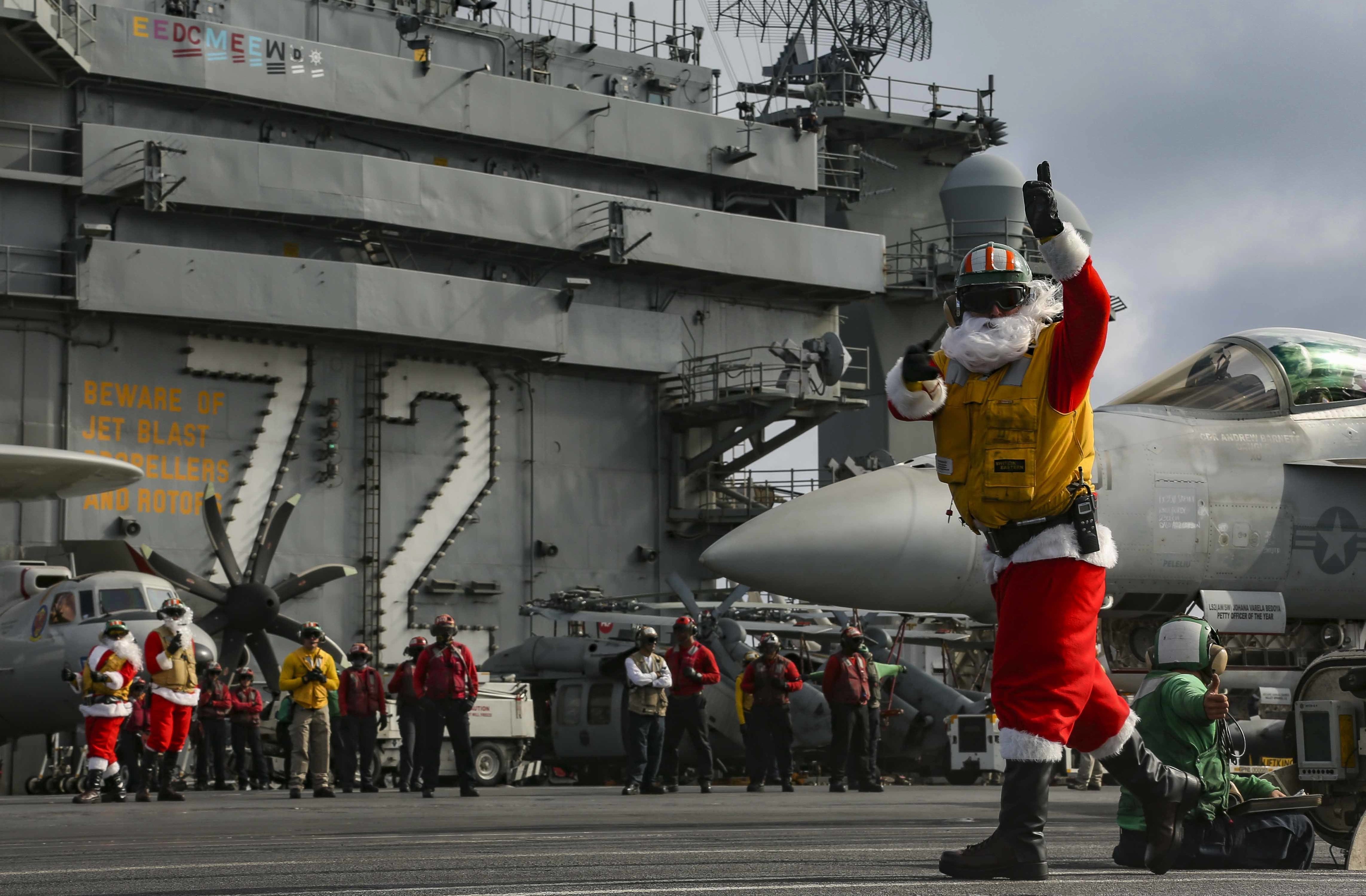
2020 began with the end of the longest carrier deployment since the 1970s. When USS Abraham Lincoln (CVN-72) pulled into San Diego Harbor in January, the carrier strike group had been deployed for 295 days. Lincoln was the first carrier rushed to the Middle East as part of then-National Security Advisor John Bolton’s campaign to increase pressure on Iran.
In total, the carrier spent 222 days in U.S. 5th Fleet as part of a deterrence mission against Iran and supporting U.S. operations in Iraq, Syria and Afghanistan.
“Our mission there was to be a deterrent force. We were the response option,” Rear Adm. Mike Boyle, then-commander of Carrier Strike Group 12, told USNI News at the end of the deployment. “I truly believe, and it’s not a talking point – is our presence in the Middle East prevented us from going to war with Iran. There’s no doubt in my mind.”
The following are the units that deployed with the carrier in April.
Carrier Strike Group 12
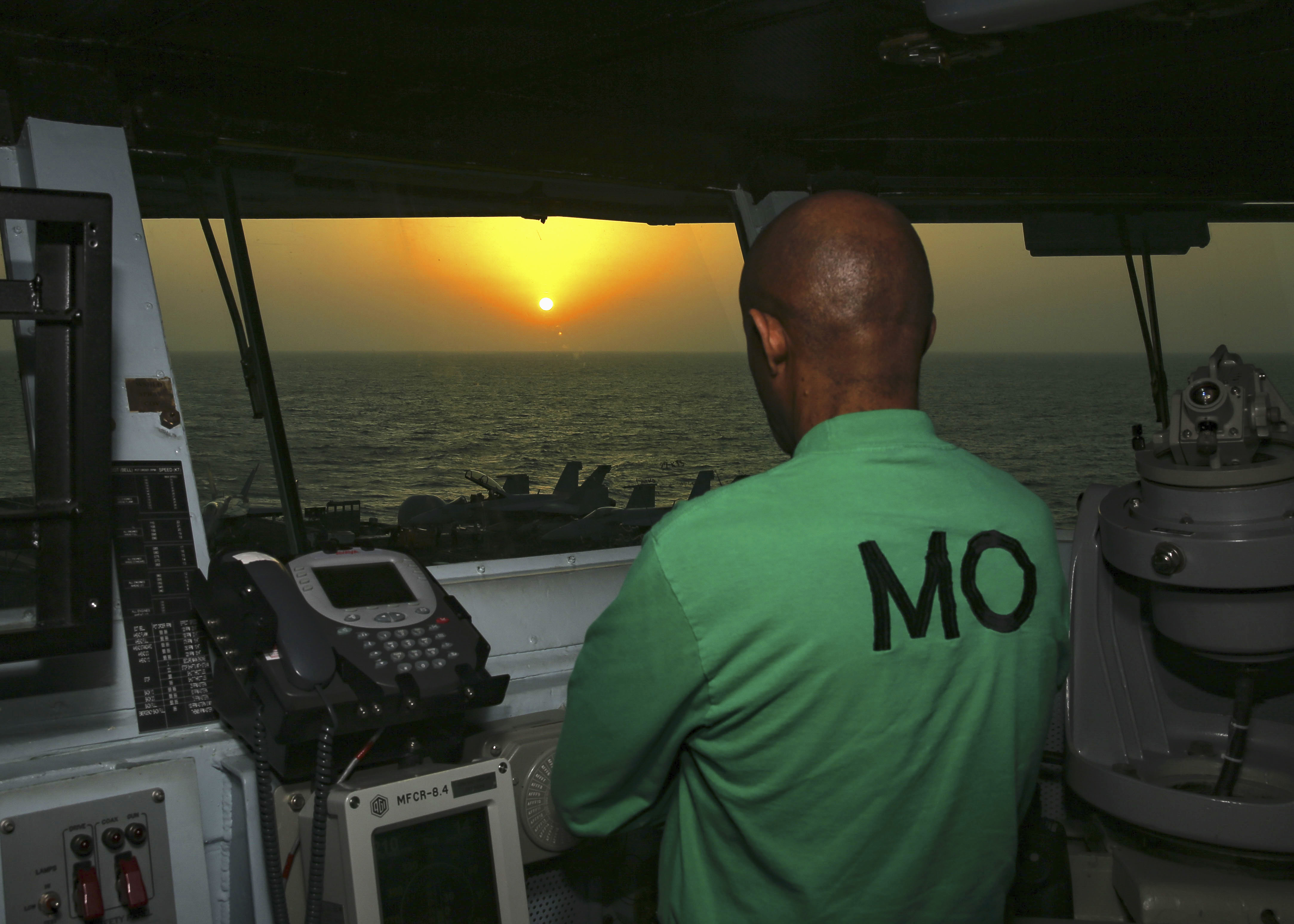
The Norfolk-based CSG 12 commands the Abraham Lincoln Carrier Strike Group and was embarked on the carrier.
Aircraft carrier
USS Abraham Lincoln (CVN-72), now homeported in San Diego, Calif., at the conclusion of its deployment
Carrier Air Wing 7
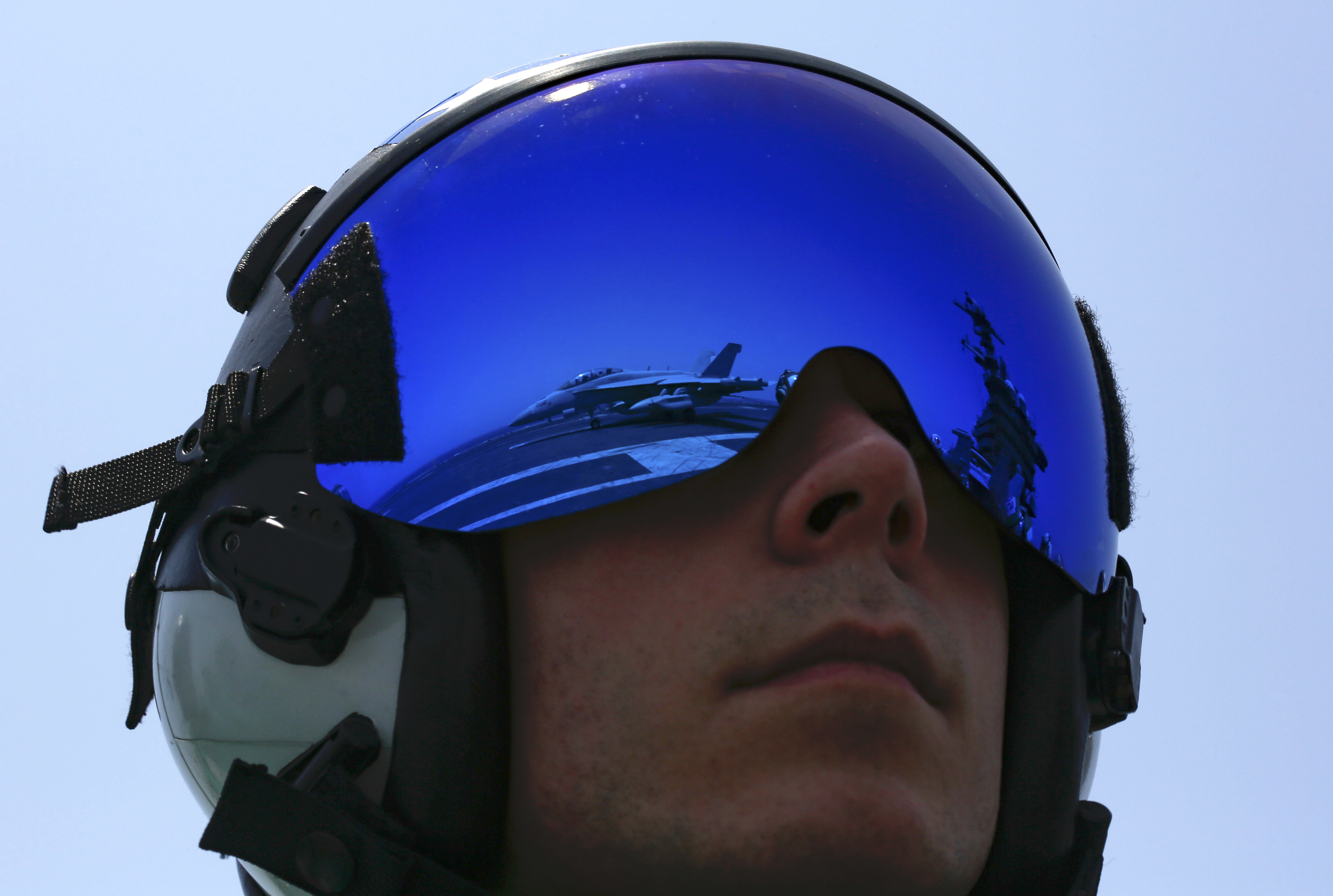
CVW 7, based at Naval Air Station Oceana, Va., was embarked aboard Lincoln and includes a total of nine squadrons and detachments:
- The “Fist of the Fleet” of Strike Fighter Squadron (VFA) 25 from Naval Air Station Lemoore, Calif.
- The “Sidewinders” of VFA-86 from Naval Air Station Lemoore, Calif.
- The “Jolly Rogers” of VFA-103 from Naval Air Station Oceana, Va.
- The “Pukin’ Dogs” of VFA-143 from Naval Air Station Oceana, Va.
- The “Patriots” of Electronic Attack Squadron (VAQ) 140 from Naval Air Station Whidbey Island, Wash.
- The “Bluetails” of Carrier Airborne Early Warning Squadron (VAW) 121 from Naval Station Norfolk, Va.
- The “Rawhides” of Fleet Logistics Support Squadron (VRC) 40 from Naval Station Norfolk, Va.
- The “Night Dippers” of Helicopter Sea Combat Squadron (HSC) 5 from Naval Station Norfolk, Va.
- The “Griffins” of Helicopter Maritime Strike Squadron (HSM) 79 from Naval Air Station North Island, Calif.
Cruiser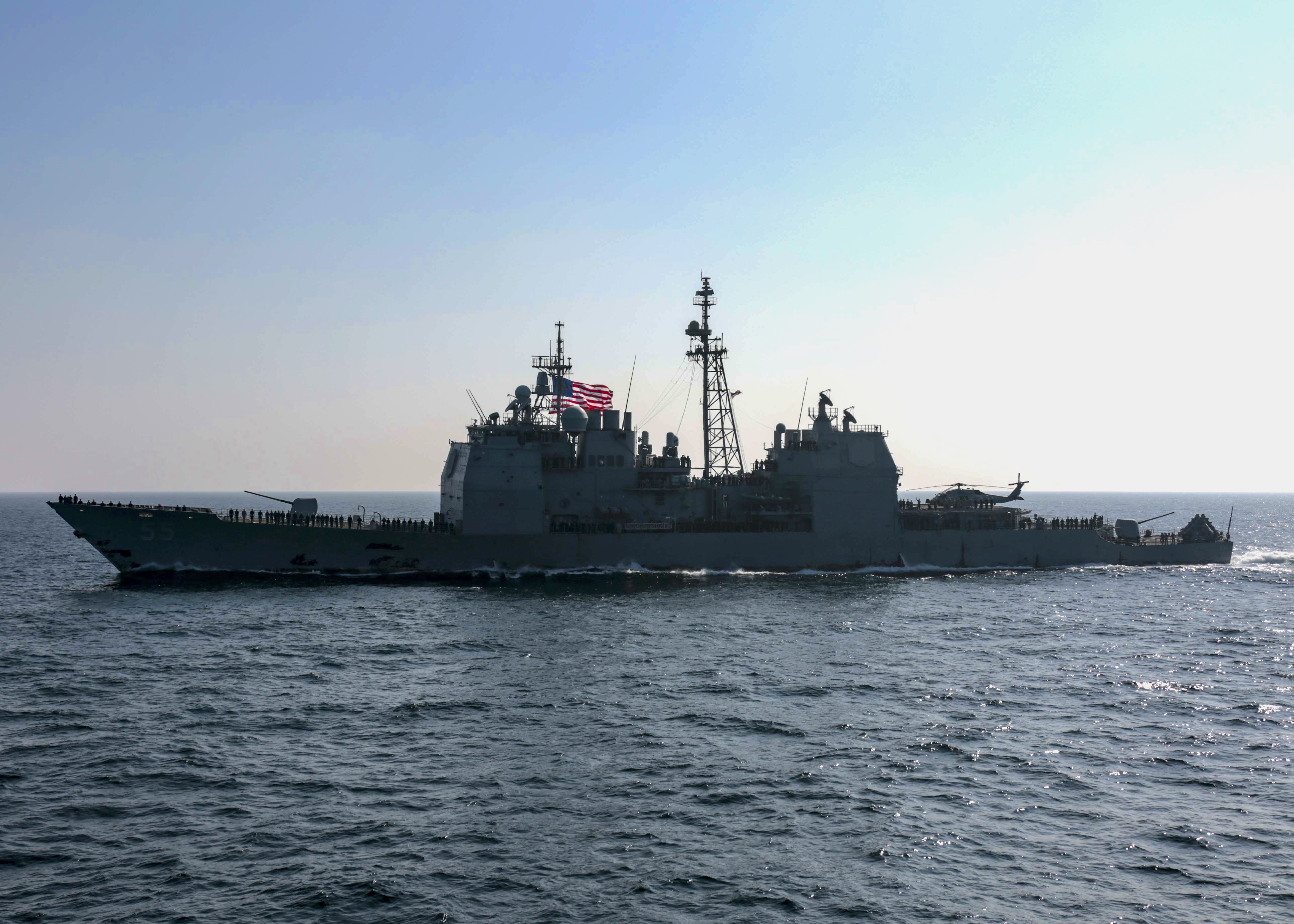
USS Leyte Gulf (CG-55) sails alongside the aircraft carrier USS Abraham Lincoln (CVN-72) on Dec. 10, 2019. US Navy Photo - USS Leyte Gulf (CG-55), homeported in Norfolk, Va.
Destroyer Squadron 2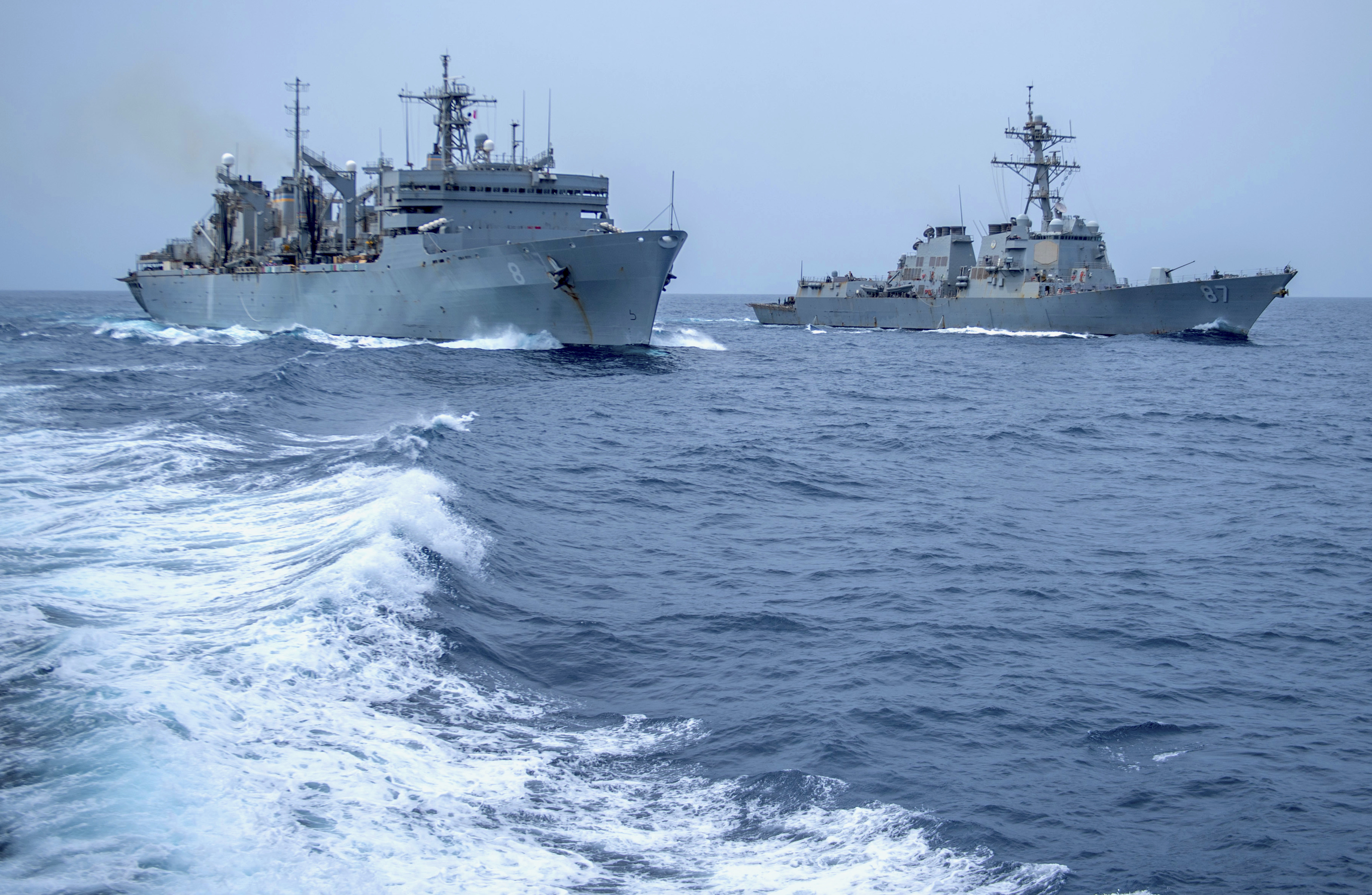
USNS Arctic (T-AOE-8), left, and the Arleigh Burke-class guided-missile destroyer USS Mason (DDG-87) steam alongside the Arleigh Burke-class guided-missile destroyer USS Bainbridge (DDG-96) during a replenishment-at-sea on July 24, 2019. US Navy Photo The leadership of DESRON 2 is embarked aboard Lincoln and commands the guided-missile destroyers that are operating as part of the CSG.
- USS Bainbridge (DDG-96), homeported in Norfolk, Va.
- USS Mason (DDG-87), homeported in Norfolk, Va.
- USS Nitze (DDG-94), homeported in Norfolk, Va.
How We Count Deployments:
USNI News uses a specific methodology to measure operational combat power. The totals are based on an internal database that does not count training exercises, certification cruises or other qualification underways, but rather only includes operational carrier deployments focused on national tasking. These also do not include COVID-19 restriction of movement (ROM) periods that add to sailors’ and Marines’ time away from home. In the case of the Navy’s forward-deployed carrier in Japan – which is technically always deployed, even while in maintenance – USNI News counts only its patrols as part of the deployment overview.
Harry S. Truman Carrier Strike Group
Nov. 18, 2019 to June 16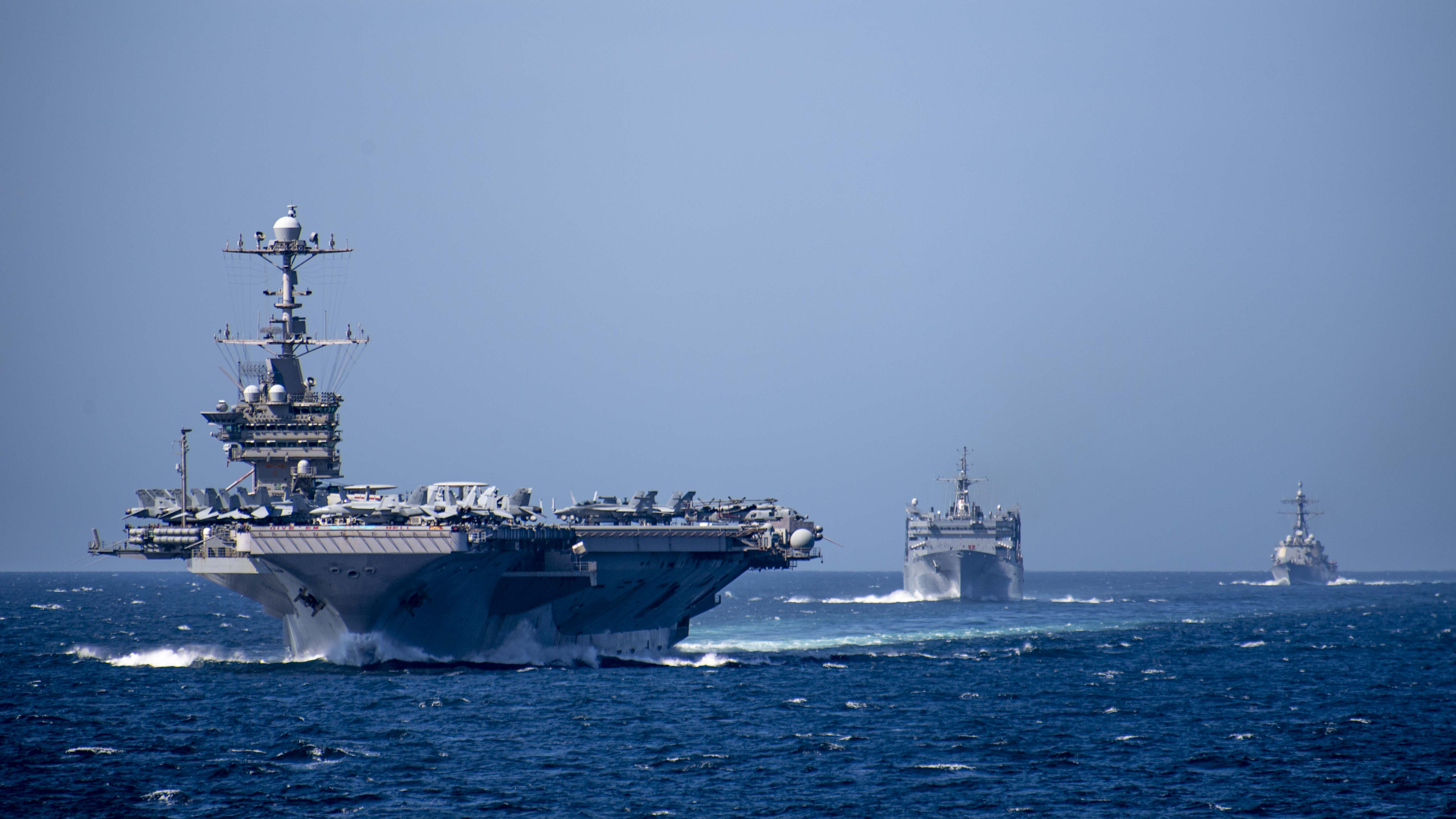
USS Harry S. Truman (CVN-75), left, the fast combat support ship USNS Supply (T-AOE-6), and the guided-missile destroyer USS Forrest Sherman (DDG-98) transit the Bab al-Mandeb Strait behind the guided-missile cruiser USS Normandy (CG-60), not pictured on Dec. 19, 2019. US Navy Photo USS Harry S. Truman (CVN-75) departed in November for a double-pump deployment two months later than planned. In late August, USNI News reported the carrier had suffered major electrical problems forcing it to delay its deployment.
In lieu of a full carrier strike group, a surface action group made up of Arleigh Burke-class guided-missile destroyers USS Lassen (DDG-82) and USS Farragut (DDG-99) from Mayport, Fla., and Norfolk-based USS Forrest Sherman (DDG-98) and Ticonderoga-class guided-missile cruiser USS Normandy (CG-60) left the East Coast in September.
The delay in departure for Truman resulted in an extension of the Lincoln CSG in the Middle East.
Truman spent the bulk of its deployment operating off the entrance to the Persian Gulf in the North Arabian Sea, as well as in the Gulf of Oman. The strike group returned to the East Coast in mid-April, however, the crew of Truman remained off the East Coast for almost two-months on a deployment extension due to concerns over the pandemic.
“We made a decision, the [Secretary of Defense] made a decision and the Navy made a decision to keep the Harry S. Truman at sea so that we had at least two carriers at sea at a moment’s notice,” Chairman of the Joint Chiefs of Staff Gen. Mark Milley said on April 14.
“That was a conscious, deliberative, operational decision in order to make sure that we had carrier strike group capability at sea.”The escorts that deployed as a surface action group stayed out for 267 days.
The following are the units that deployed with the carrier in November.
Carrier Strike Group 8
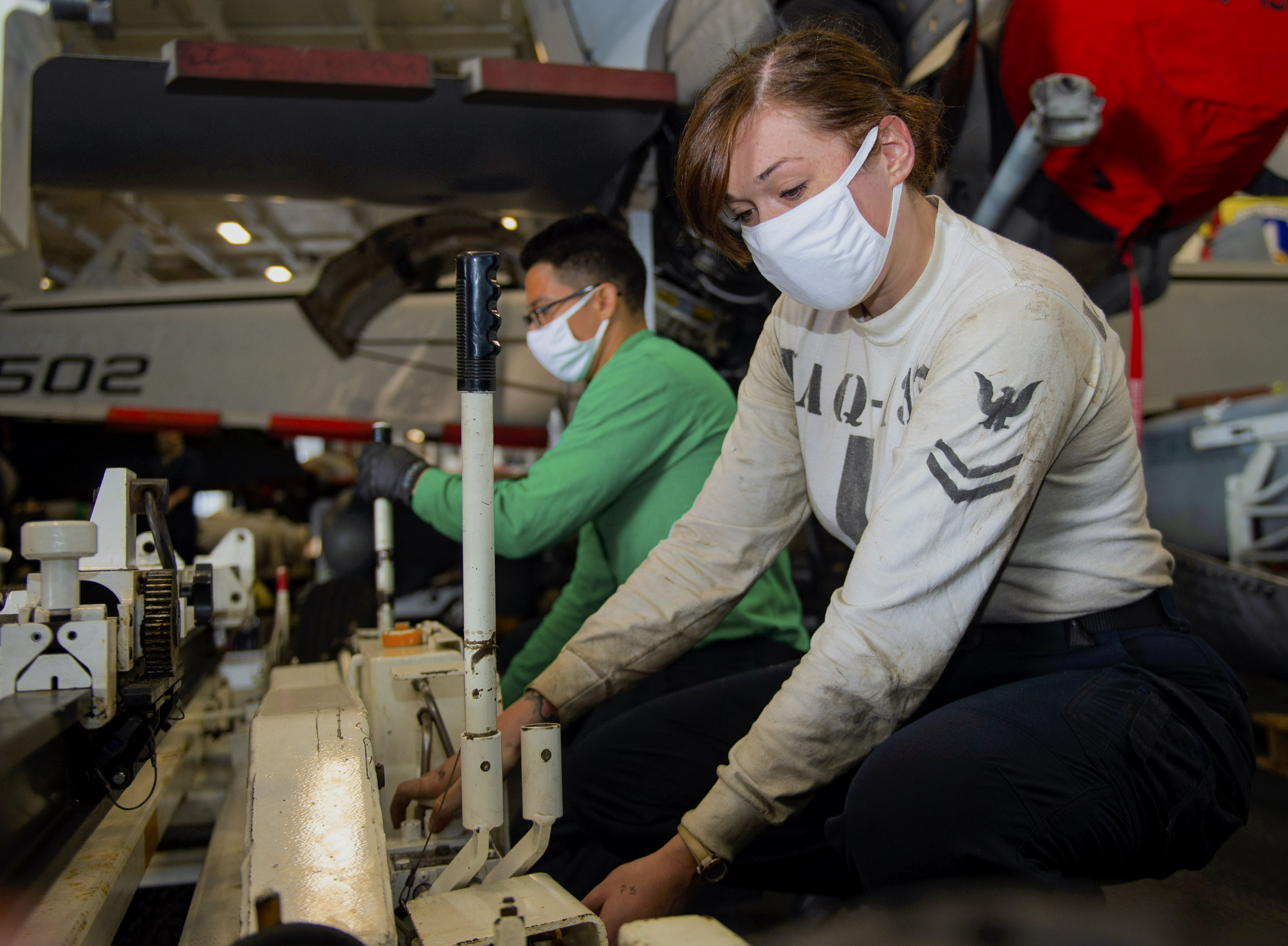
Aviation Machinist Mate 2nd Class Antonia Holland, from Port Charlotte, Fla., front, and Airman Adar Estrella, from Oceanside, Calif., operate an engine trailer in the hangar bay of the Nimitz-class aircraft carrier USS Harry S. Truman (CVN 75) in the Atlantic Ocean, May 13, 2020. US Navy Photo Norfolk-based CSG 8 commanded the Harry S. Truman CSG and was embarked on the carrier.
Aircraft carrier
USS Harry S. Truman (CVN-75), homeported in Norfolk, Va.Carrier Air Wing 1
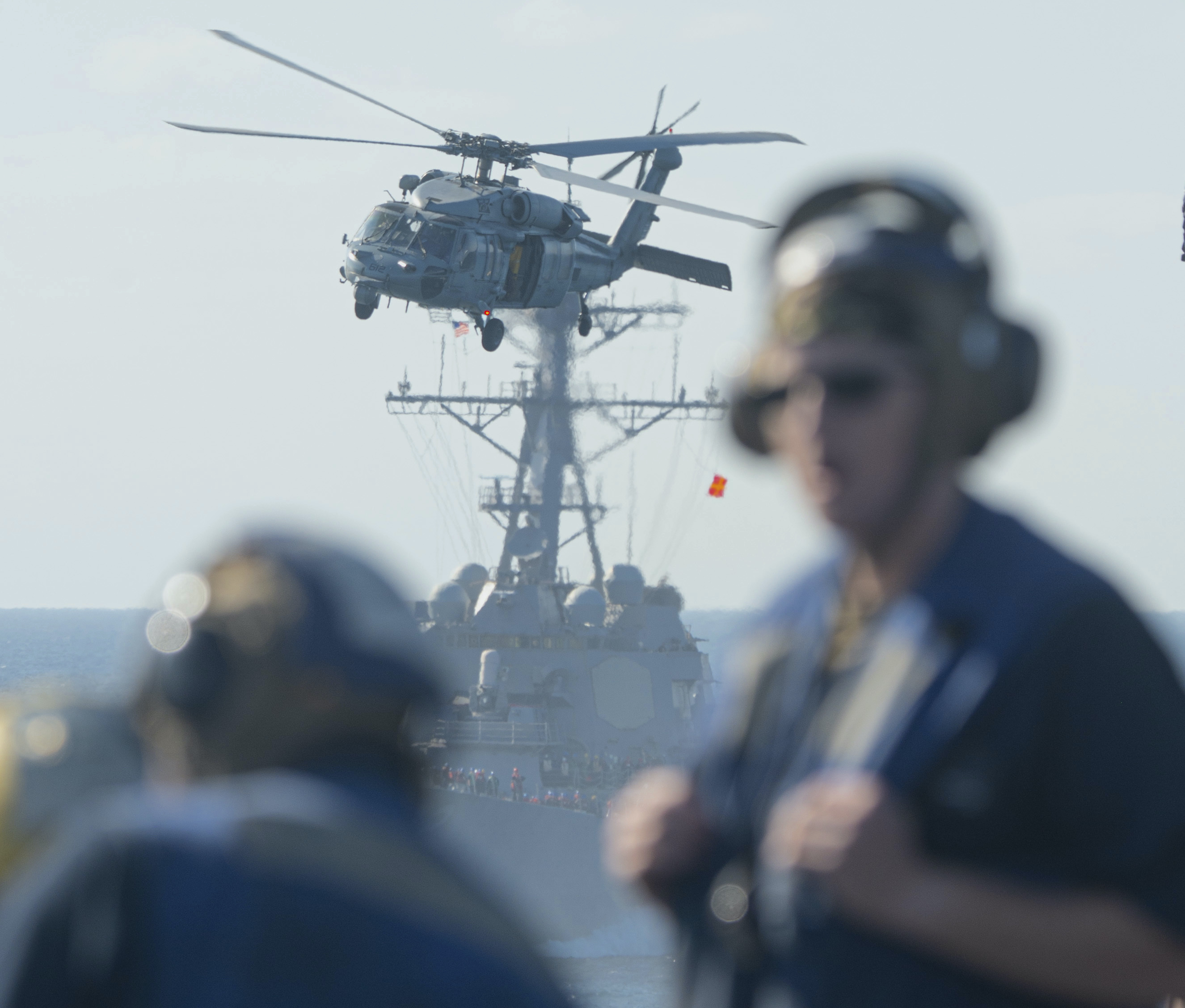
An MH-60S Knight Hawk helicopter, attached to the ‘Dragon Slayers’ of Helicopter Sea Combat Squadron (HSC) 11, transports cargo from the fast combat support ship USNS Supply (T-AOE-6) on Feb. 8, 2020. US Navy Photo Carrier Air Wing 1 is based at Naval Air Station Oceana, Va., was embarked on Harry S. Truman:
- The “Red Rippers” of VFA-11 – Strike Fighter Squadron (VFA) – from Naval Air Station Oceana – Va.
- The “Checkmates” of VFA-211 from Naval Air Station Oceana – Va.
- The “Sunliners” of VFA-81 from Naval Air Station Oceana – Va.
- The “Knighthawks” of VFA-136 from Naval Air Station Lemoore – Calif.
- The “Rooks” of VAQ-137 – Electronic Attack Squadron (VAQ) – from Naval Air Station Whidbey Island – Wash.
- The “Seahawks” of VAW-126 – Carrier Airborne Early Warning Squadron (VAW) – from Naval Air Station Norfolk – Va.
- The “Rawhides” of VRC-40 – Detachment – Fleet Logistics Support Squadron (VRC) – from Naval Air Station Norfolk – Va.
- The “Dragon Slayers” of HSC-11 – Helicopter Sea Combat Squadron (HSC) – from Naval Air Station Norfolk – Va.
- The “Proud Warriors” of HSM-72 – Helicopter Maritime Strike Squadron (HSM) – from Naval Air Station Jacksonville – Fla.
Surface Escorts

The guided-missile destroyer USS Bainbridge (DDG 96) sails in the Arabian Sea. Bainbridge is deployed to the U.S. 5th Fleet area of operations in support of naval operations to ensure maritime stability and security in the Central Region. US Navy photo. USS Bainbridge (DDG-96), homeported in Norfolk, Va.
USS McFaul (DDG-74), homeported in Norfolk, Va.Theodore Roosevelt Carrier Strike Group
Jan. 17 – July 9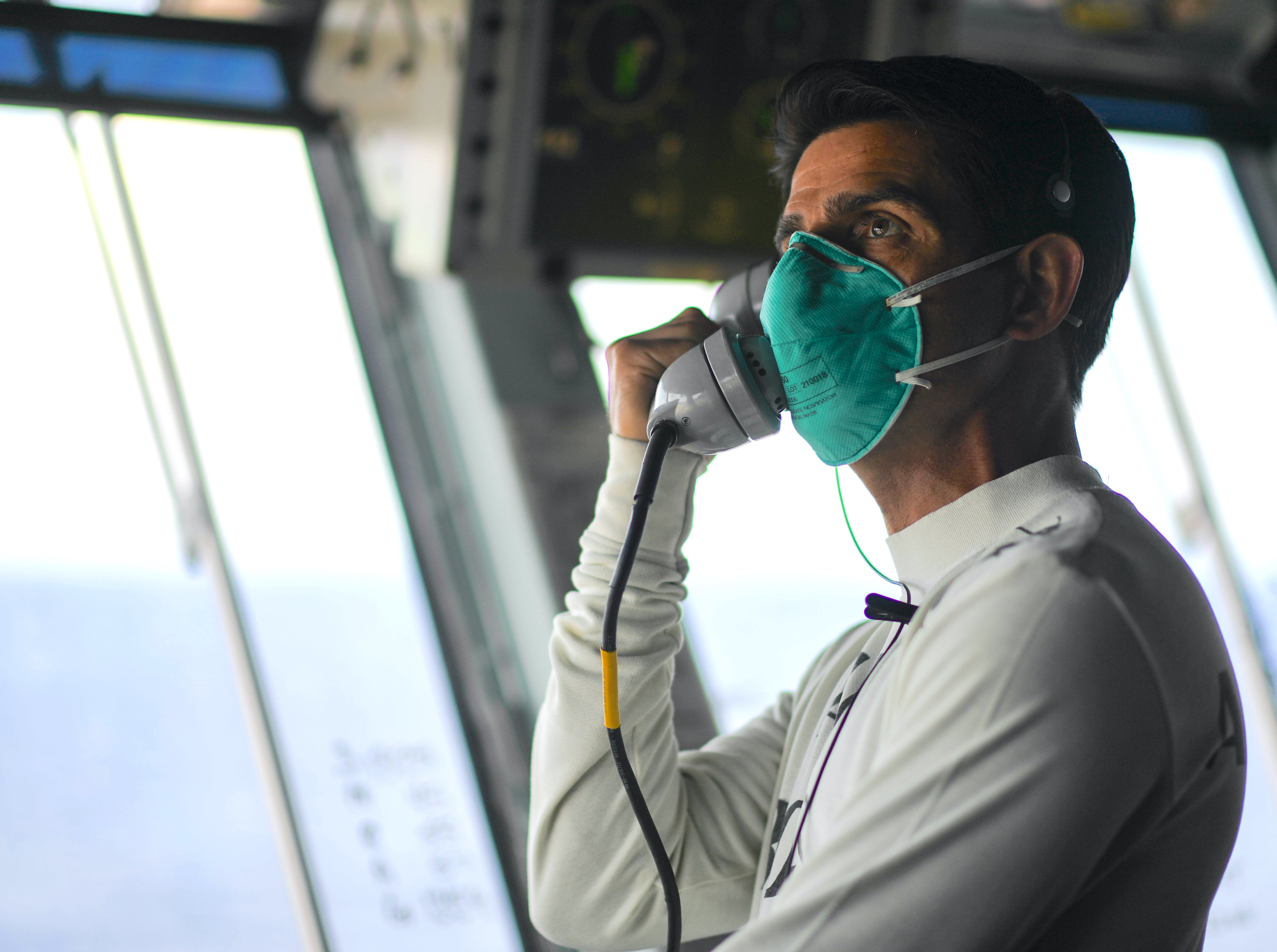
Cmdr. Steven Vitrella, air boss aboard the aircraft carrier USS Theodore Roosevelt (CVN-71), uses a phone to talk to flight deck control during flight operations on May 27, 2020. US Navy Photo The Theodore Roosevelt CSG deployment was the most visible front of the military’s fight against the COVID-19 pandemic. Following a port visit in March to Vietnam, the outbreak brought USS Theodore Roosevelt (CVN-71) pier-side in Guam for more than two months. More than 1,200 sailors contracted the virus, and one sailor died: Chief Petty Officer Charles Robert Thacker Jr.
As the ship was pier-side, Navy and Pentagon leaders insisted the strike group could get underway if the need was dire.
While the carrier was sidelined, its escorts were tasked with other missions, including the expanded Navy counter-drug effort in U.S. Southern Command.
The carrier got back to sea on June 4 and conducted dual-carrier operations with the Nimitz CSG before returning to San Diego.
The carrier continued sustainment exercises up its return to port and departed for a final exercise on Dec. 7. The strike group commenced its second deployment Dec. 23.
The following are the units that deployed with the carrier in January.
Carrier Strike Group 9
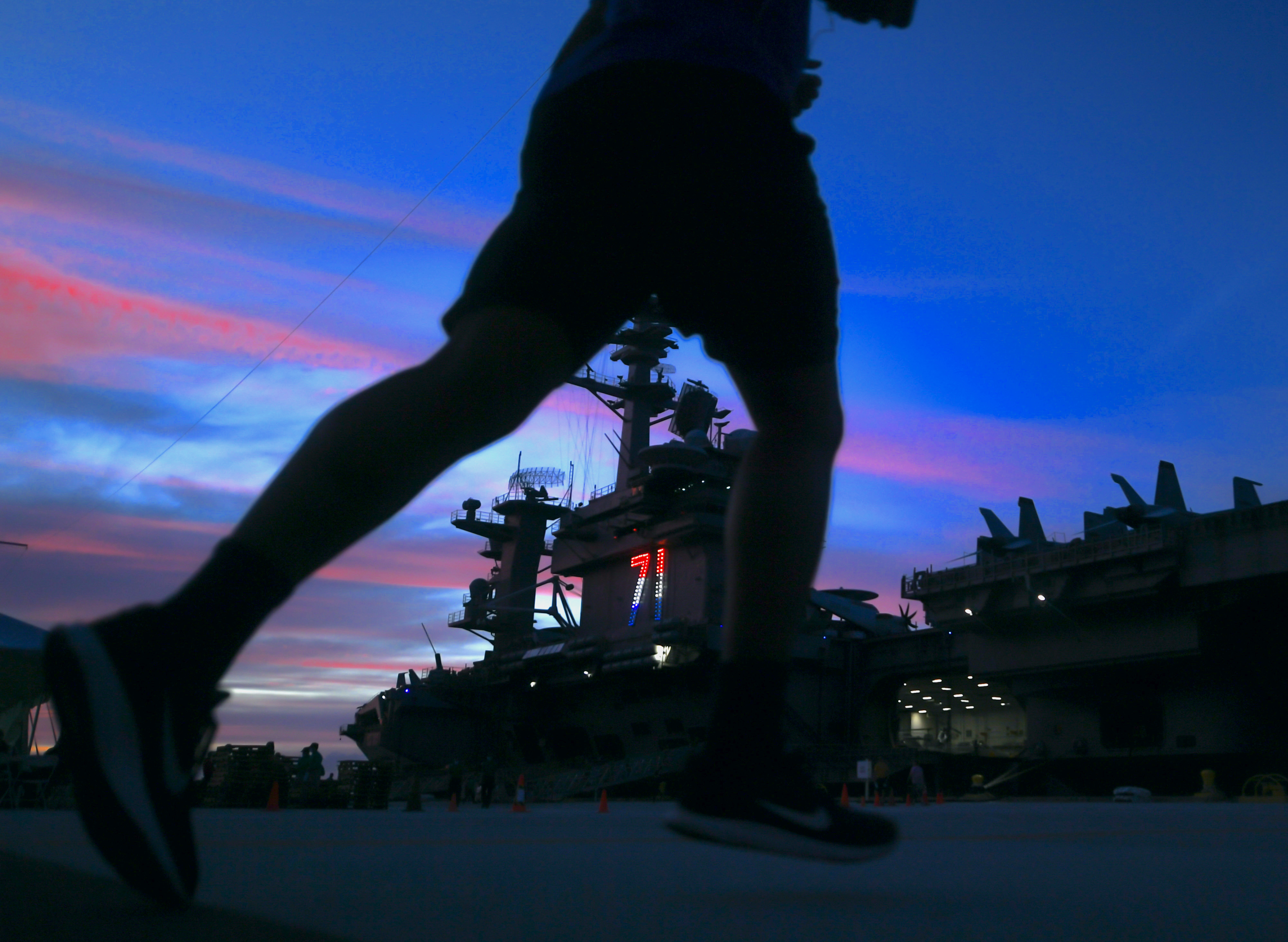
Sailor assigned to the aircraft carrier USS Theodore Roosevelt (CVN-71), runs on the pier of Naval Base Guam on May 8, 2020. US Navy Photo The San Diego-based CSG 9 commands the Theodore Roosevelt Carrier Strike Group and was embarked on the carrier.
Aircraft carrier
USS Theodore Roosevelt (CVN-71), homeported in San Diego, Calif.Carrier Air Wing 11
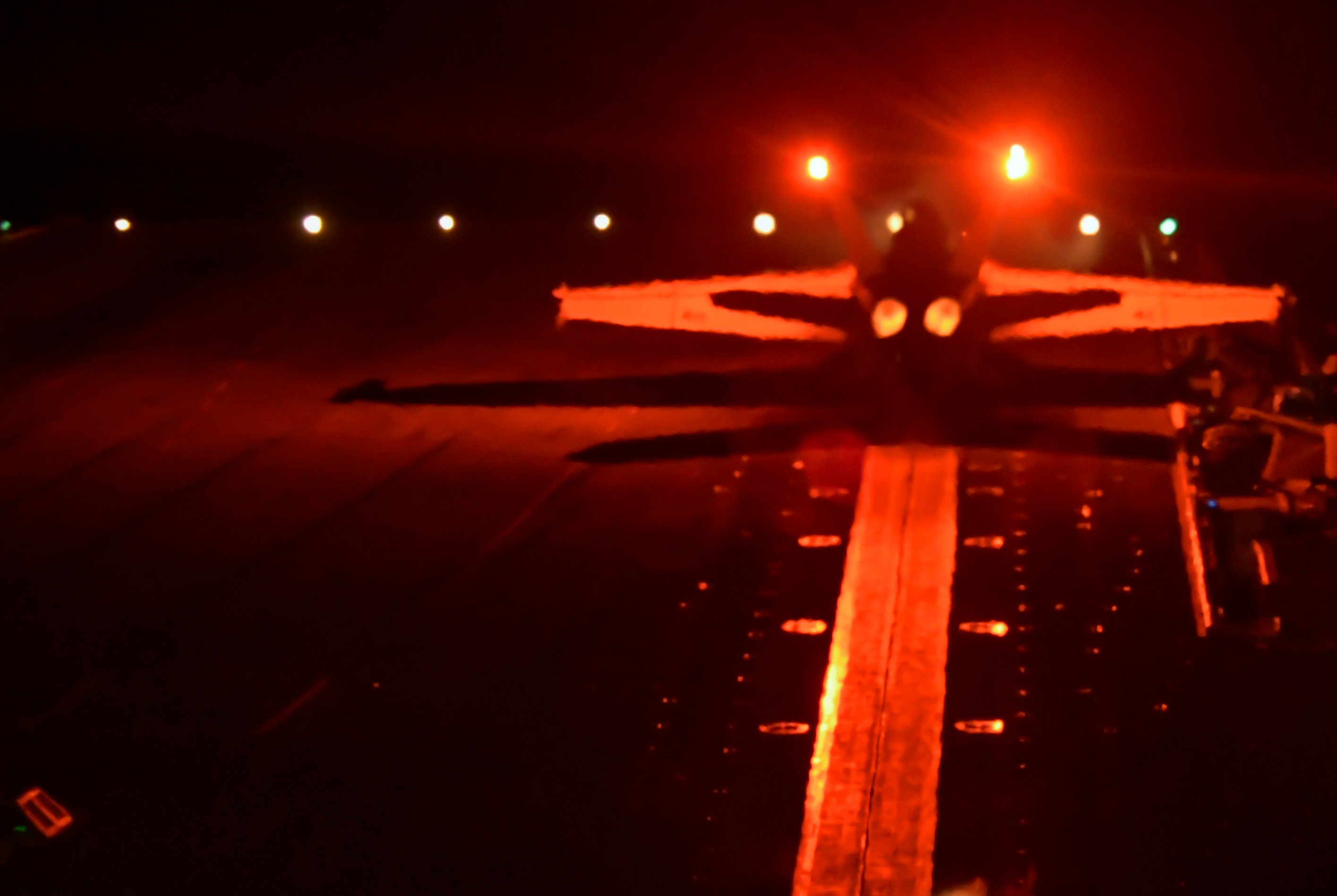
An F/A-18E Super Hornet, assigned to the “’olden Warriors’ of Strike Fighter Squadron (VFA) 87, launches from the flight deck of the aircraft carrier USS Theodore Roosevelt (CVN-71) on May 26, 2020. US Navy Photo Carrier Air Wing (CVW) 11, based at Naval Air Station Lemoore, Calif., was embarked aboard Theodore Roosevelt and includes a total of nine squadrons and detachments:
- The “Tomcatters” of VFA-31 – Strike Fighter Squadron (VFA) – from Naval Air Station Oceana, Va.
- The “Golden Warriors” of VFA-87 from Naval Air Station Oceana, Va.
- The “Blue Diamonds” of VFA-146 from Naval Air Station Lemoore, Calif.
- The “Black Knights” of VFA-154 from Naval Air Station Lemoore – Calif.
- The “Gray Wolves” of VAQ-142 – Electronic Attack Squadron (VAQ) – from Naval Air Station Whidbey Island – Wash.
- The “Liberty Bells” of VAW-115 – Carrier Airborne Early Warning Squadron (VAW) – from Naval Air Station Point Mugu, Calif.
- The “Providers” of VRC-30 – Detachment – Fleet Logistics Support Squadron (VRC) – from Naval Air Station North Island, Calif.
- The “Eight Ballers” of HSC-8 – Helicopter Sea Combat Squadron (HSC) – from Naval Air Station North Island, Calif.
- The “Wolf Pack” of HSM-75 – Helicopter Maritime Strike Squadron (HSM) – from Naval Air Station North Island, Calif.
Cruiser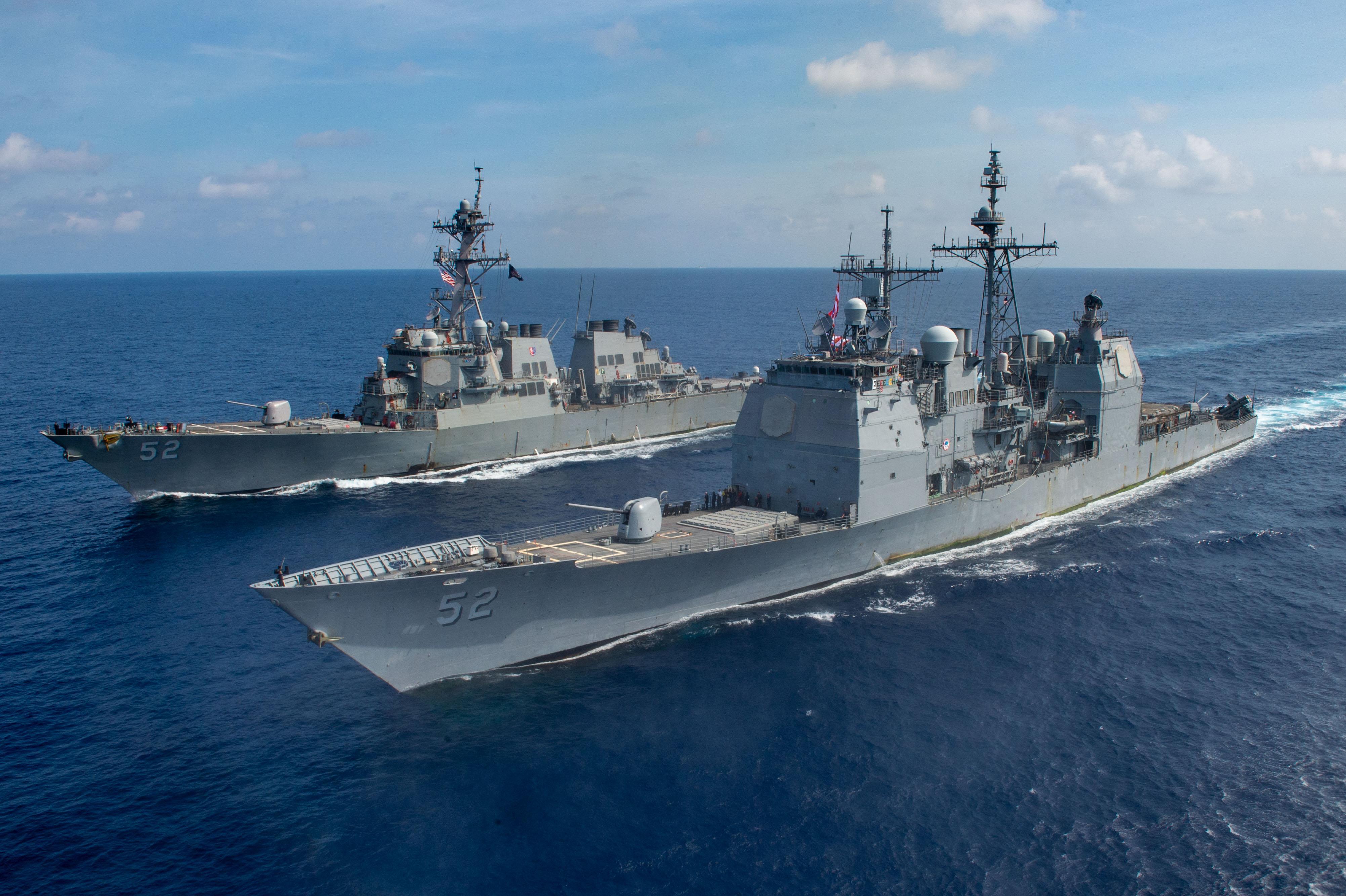
Ticonderoga-class guided missile cruiser USS Bunker Hill (CG-52), front, and the Arleigh Burke-class guided-missile destroyer USS Barry (DDG-52) transit the South China Sea April 18, 2020. US Navy Photo USS Bunker Hill (CG-52), homeported in San Diego, Calif.
Destroyer Squadron 23
Destroyer Squadron 23 is based in San Diego and was embarked on the carrier.Destroyers
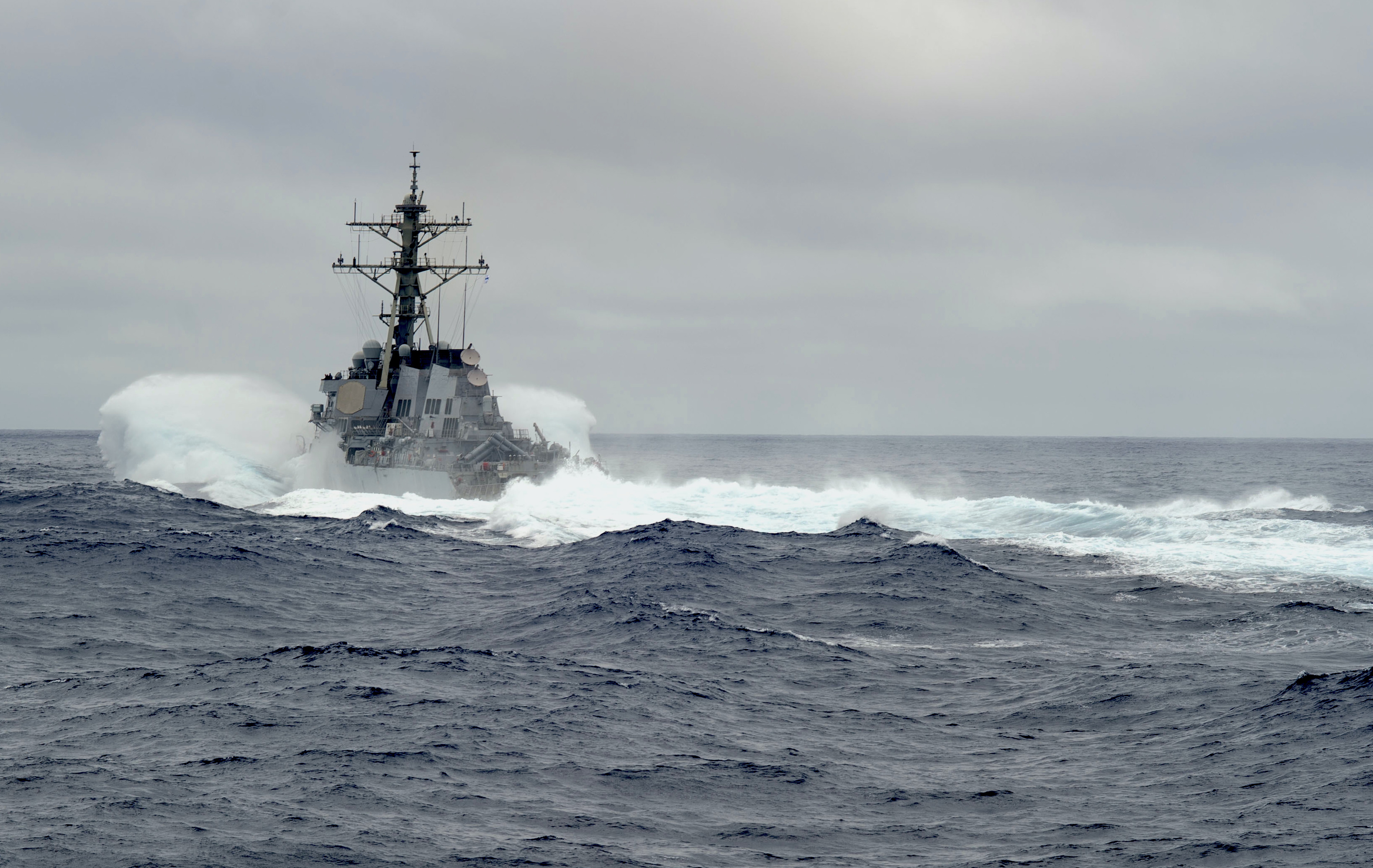
Arleigh Burke-class guided-missile destroyer USS Russell (DDG-59) conducts a break away during a replenishment-at-sea. Rafael Peralta is deployed to the U.S. 7th Fleet area of operations in support of security and stability in the Indo-Pacific region. US Navy Photo - USS Russell (DDG-59), homeported in San Diego, Calif.
- USS Paul Hamilton (DDG-60), homeported in San Diego, Calif.
- USS Pinckney (DDG-91), homeported in San Diego, Calif.
- USS Rafael Peralta (DDG-115), homeported in San Diego, Calif.
- USS Kidd (DDG-100), homeported, Everett, Wash.
Dwight D. Eisenhower Carrier Strike Group
Feb. 20 to Aug. 9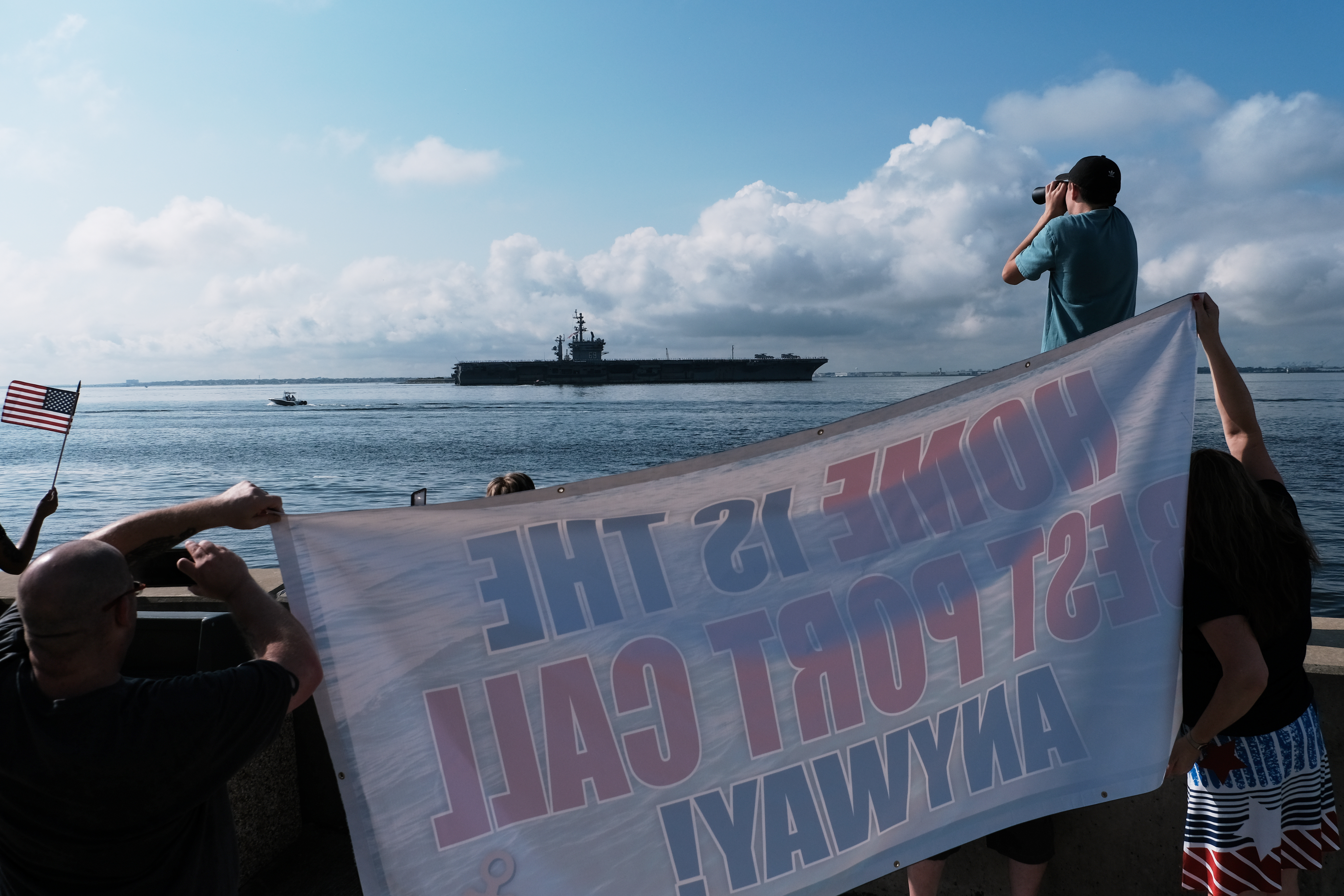
Friends and family members greet the Nimitz-class aircraft carrier USS Dwight D. Eisenhower (CVN-69) as the ship returns to Naval Station Norfolk, Va., after a regularly scheduled deployment in support of maritime security operations and theater security cooperation efforts in U.S. 5th and 6th Fleet on Aug. 9, 2020. US Navy Photo USS Dwight D. Eisenhower (CVN-69) left Naval Station Norfolk on Jan. 17 to begin its final exercise ahead of its deployment. Completing certification on Feb. 20, the carrier headed to the Middle East to relieve Truman. The carrier stayed on station with no port calls for seven months.
Eisenhower stayed in 5th Fleet until the Nimitz Carrier Strike Group deployed from the West Coast in late July.
Eisenhower and cruiser USS San Jacinto (CG-56) pulled into Naval Station Norfolk on Aug. 9. Cruiser USS Vella Gulf (CG-72) and destroyers USS James E. Williams (DDG-95) and USS Truxtun (DDG-103) followed shortly thereafter.
USS Stout (DDG-55) remained at sea for more than a month more as part of operations under Task Force (TF) 50, TF 51/5, and Coalition Task Force (CTF) Sentinel, the operational arm of the International Maritime Security Construct (IMSC) in the Middle East.
The following are the units that deployed with the carrier in August.
Carrier Strike Group 10

Master-at-Arms Seaman Travis Bell boxes in the seaside gym aboard the aircraft carrier USS Dwight D. Eisenhower (CVN-69) on July 7, 2020. US Navy Photo Norfolk-based CSG 10 commands the Dwight D. Eisenhower CSG and is embarked on the carrier.
Aircraft carrier
USS Dwight D. Eisenhower (CVN-69), homeported in Norfolk, Va.
Carrier Air Wing
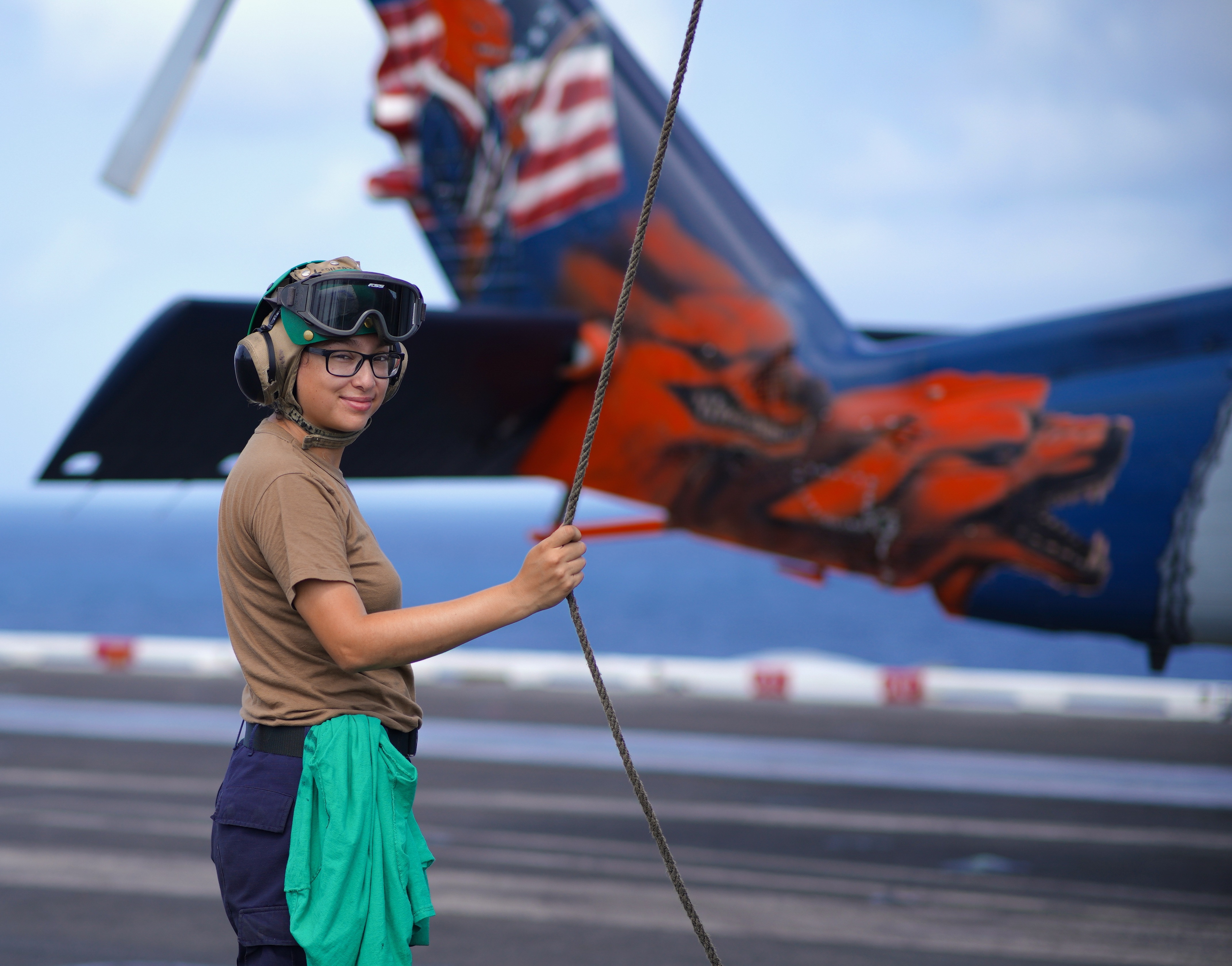
Aviation Machinist Mate Second Class Joanne Sartain, assigned to Helicopter Maritime Strike Squadron 74, performs a pre-flight driveshaft test on a helicopter onboard the aircraft carrier USS Dwight D. Eisenhower (CVN-69) prior to flight operations on May 22, 2020. US Navy Photo Carrier Air Wing (CVW) 3, based at Naval Air Station Oceana, Va., is embarked aboard Dwight D. Eisenhower and includes a total of nine squadrons and detachments:
- The “Gunslingers” of VFA-105 – Strike Fighter Squadron (VFA) – from Naval Air Station Oceana, Va.
- The “Wildcats” of VFA-131 from Naval Air Station Oceana, Va.
- The “Swordsmen” of VFA-32 from Naval Air Station Oceana, Va.
- The “Rampagers” of VFA-83 from Naval Air Station Oceana, Va.
- The “Zappers” of VAQ-130 – Electronic Attack Squadron (VAQ) – from Naval Air Station Whidbey Island – Wash.
- The “Screwtops” of VAW-123 – Carrier Airborne Early Warning Squadron (VAW) – from Naval Station Norfolk, Va.
- The “Rawhides” of VRC-40 – Detachment – Fleet Logistics Support Squadron (VRC) – from Naval Station Norfolk, Va.
- The “Dusty Dogs” of HSC-7 – Helicopter Sea Combat Squadron (HSC) – from Naval Station Norfolk, Va.
- The “Swamp Foxes” of HSM-74 – Helicopter Maritime Strike Squadron (HSM) – from Naval Air Station Jacksonville, Fla.
Cruiser
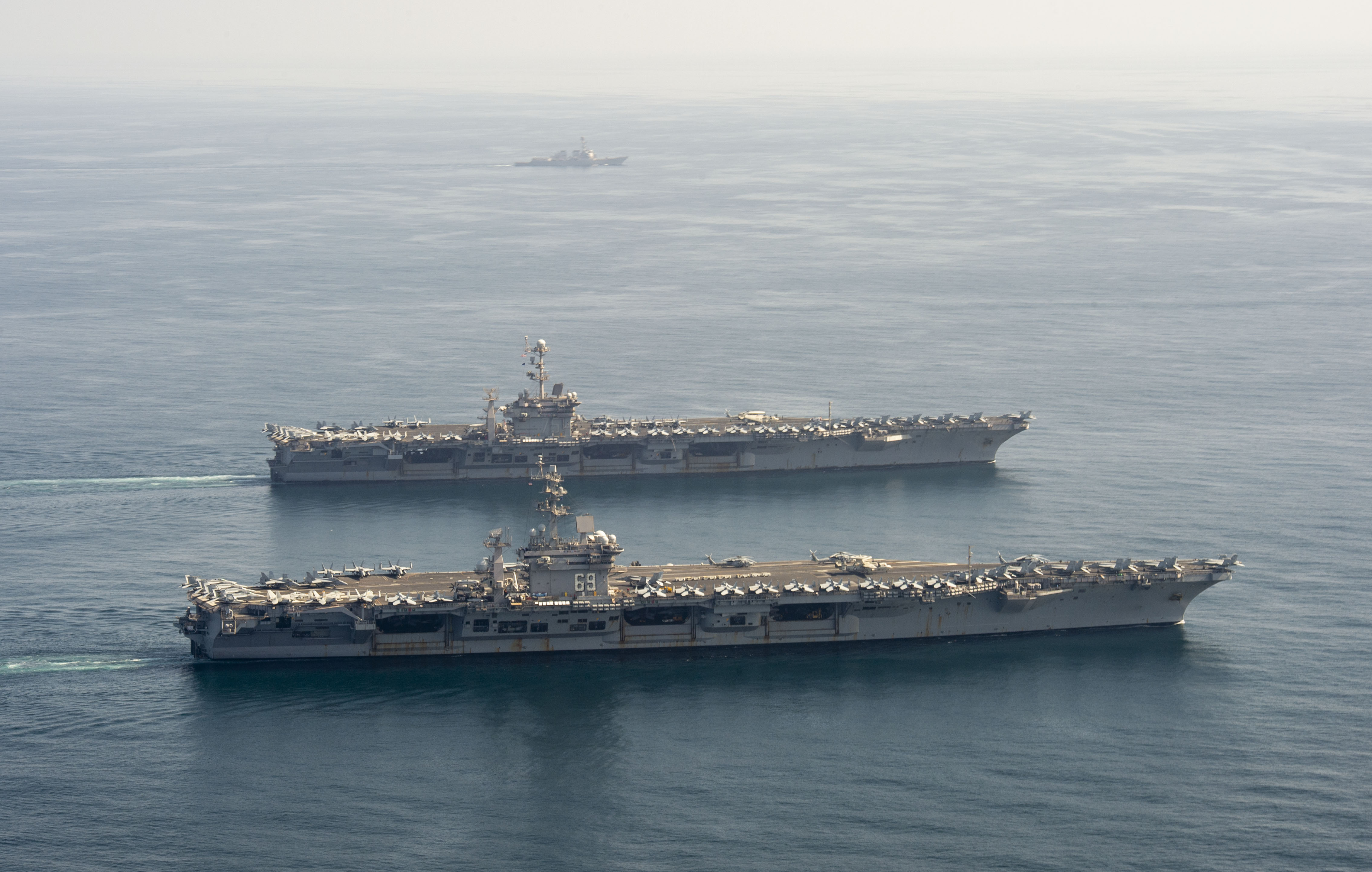
The aircraft carriers USS Dwight D. Eisenhower (CVN 69), front, and USS Harry S. Truman (CVN 75), and the guided-missile destroyer USS Lassen (DDG 82) transit the Arabian Sea, March 18, 2020. US Navy photo. USS Vella Gulf (CG-72), homeported in Norfolk, Va.
USS San Jacinto (CG-56), homeported in Norfolk, Va.Destroyer Squadron 26
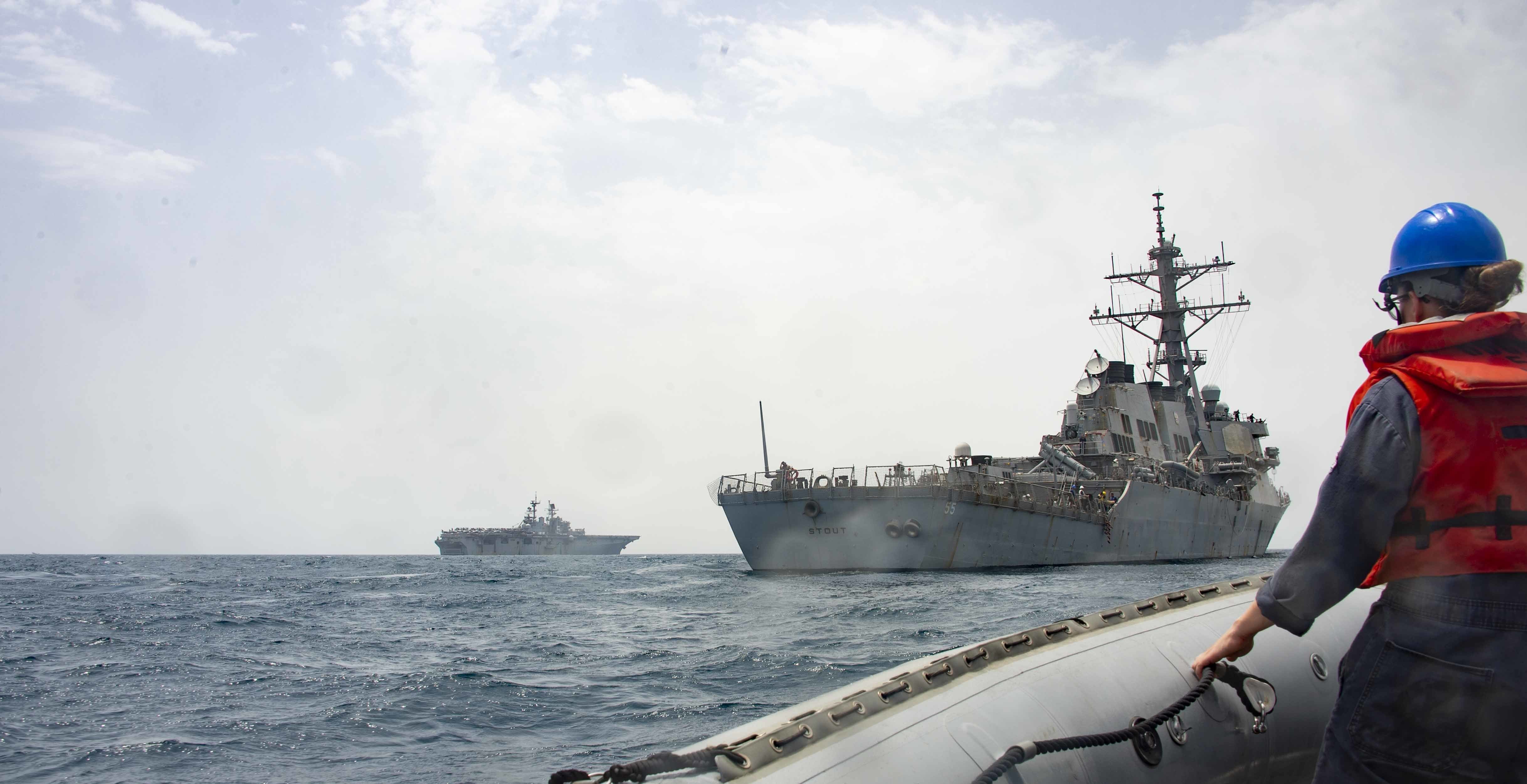
The guided-missile destroyer USS Stout (DDG 55), right, and the amphibious assault ship USS Bataan (LHD-5) transits the Arabian Gulf April 26 2020. U.S. Navy Photo Destroyer Squadron 26 is based at Norfolk, and its leaders are embarked on Eisenhower.
- USS Stout (DDG-55), homeported in Mayport, Fla.
- USS James E. Williams (DDG-95), homeported in Mayport, Fla.
- USS Truxtun (DDG-103), homeported in Norfolk, Va.
- Royal Danish Navy frigate Iver Huitfeldt (F361)
Nimitz Carrier Strike Group
June 8 to Present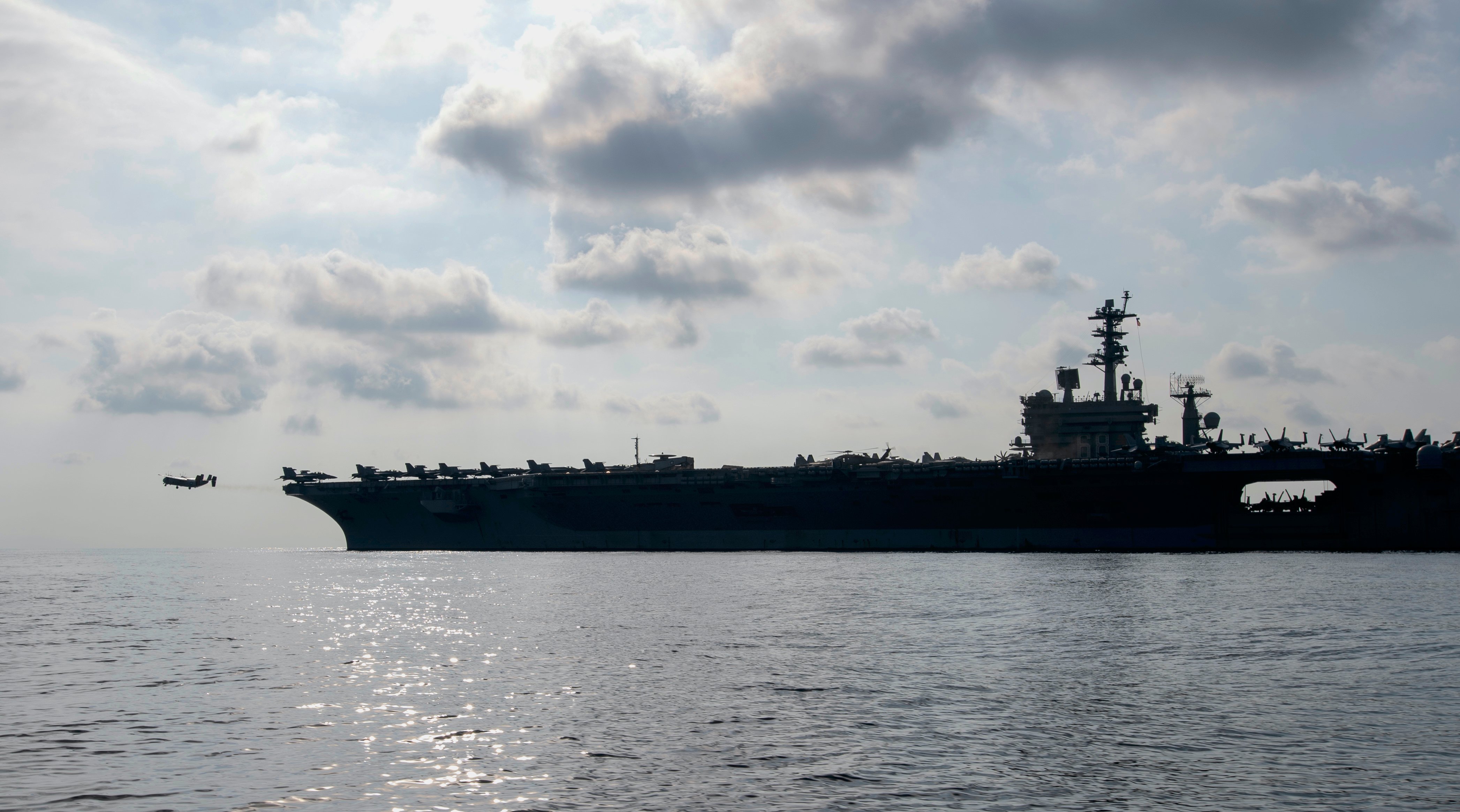
A C-2A Greyhound, from the ‘Providers’ of Fleet Logistics Support Squadron (VRC) 30, launches off the flight deck of the aircraft carrier USS Nimitz (CVN-68) on Dec. 9, 2020. US Navy Photo The crew of USS Nimitz (CVN-68) and its escorts and air wing were the first carrier strike group to prepare to deploy under the Navy’s emerging COVID-19 protection scheme. Unlike the other strike groups that left their homeports before the pandemic, the Navy had to navigate restrictions to protect against the virus just as the ship was leaving maintenance.
In April, the crew of Nimitz began their isolation period in Washington state ahead of their deployment, while the air wing, strike group staff and escorts did the same in California.
The carrier sailed from Washington to California in in late April and drilled for most of May before departing on deployment in early June.
In late June, Nimitz and Theodore Roosevelt paired up in the Philippine Sea, while Reagan operated nearby. On July 4, Nimitz and Reagan “celebrated Independence Day with unmatched sea power while deployed to the South China Sea conducting dual-carrier operations and exercises in support of a free and open Indo-Pacific,” according to a statement from U.S. 7th Fleet at the time.
The Nimitz CSG passed through the South China Sea in late July and took the place of Eisenhower CSG.
In September, Nimitz and its escorts entered the Persian Gulf – the first for a carrier in 2020. In November, Nimitz drilled with the Indian Navy and then returned to 5th Fleet.
In late December, Nimitz and the Makin Island Amphibious Ready Group were positioned off the coast of Somalia to support the move of 700 U.S. troops to other countries in Eastern Africa.
After initially announcing the strike group was set to return, acting Defense Secretary Chris Miller said Nimitz and its escorts would remain in the Middle East for an indefinite period.
Carrier Strike Group 11

Vice Adm. Samuel Paparo, commander of U.S. Naval Forces Central Command, U.S. 5th Fleet and Combined Maritime Forces, watches the aircraft carrier USS Nimitz (CVN-68) from the bridge wing of the coastal patrol ship USS Squall (PC-7) in the Persian Gulf on Nov. 8, 2020. US Navy Photo San Diego-based CSG 11 commands the Nimitz CSG and is embarked on the carrier.
Aircraft carrier
USS Nimitz (CVN-68), homeported in Bremerton, Wash.Carrier Air Wing 17
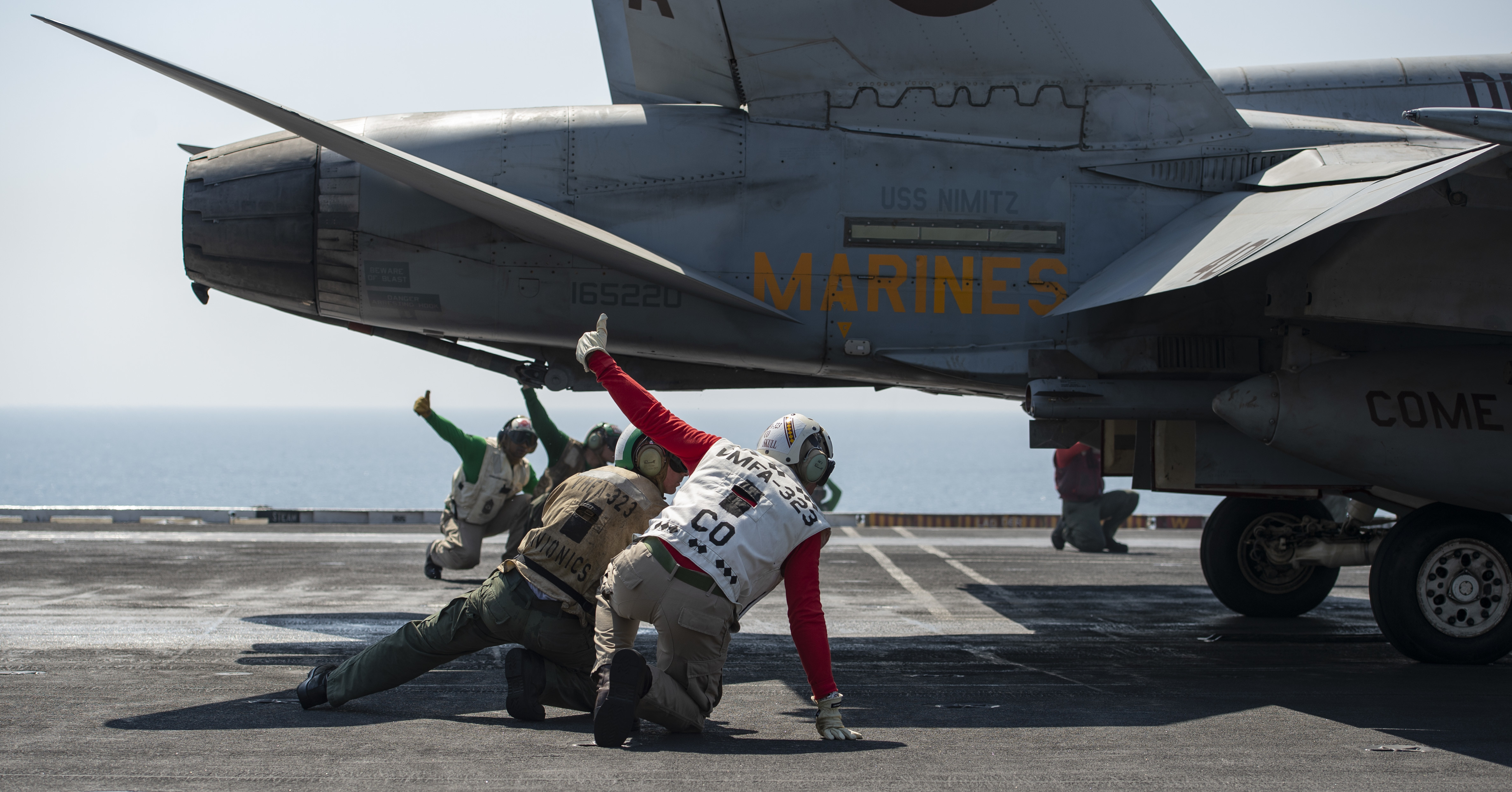
Marines conduct flight operations on the flight deck of the aircraft carrier USS Nimitz (CVN-68) in support of Operation Inherent Resolve on Sept. 22, 2020. US Navy Photo Carrier Air Wing 17, based at Naval Air Station Lemoore, Calif., is embarked on Nimitz and includes a total of nine squadrons and detachments:
- The “Redcocks” of VFA 22 – Strike Fighter Squadron (VFA) F/A-18F Super Hornet – from Naval Air Station Lemoore, Calif.
- The “Kestrels” of VFA137 F/A-18 E – from Naval Air Station Lemoore, Calif.
- The “Mighty Shrikes” of VFA 94 F/A-18F – from Naval Air Station Lemoore, Calif.
- The “Death Rattlers” of VMFA-323 F/A-18C – from Marine Corps Air Station Miramar San Diego, Calif.
- The “Cougars” of VAQ-139 – Electronic Attack Squadron (VAQ) EA-18G Growlers – from Naval Air Station Whidbey Island – Wash.
- The “Sun Kings” of VAW-116 –Carrier Airborne Early Warning Squadron (VAW) E2C Hawkeye – from Naval Air Station Point Mugu, Calif.
- The “Providers” of VRC-30 – Detachment – Fleet Logistics Support Squadron (VRC) C-2 – from Naval Air Station North Island, Calif.
- The “Screamin’ Indians” of HSC-6 – Helicopter Sea Combat Squadron (HSC) MH-60S– from Naval Air Station North Island, Calif.
- The “Battlecats” of HSM-73 – Helicopter Maritime Strike Squadron (HSM) MH-60R – from Naval Air Station North Island, Calif.
Cruiser
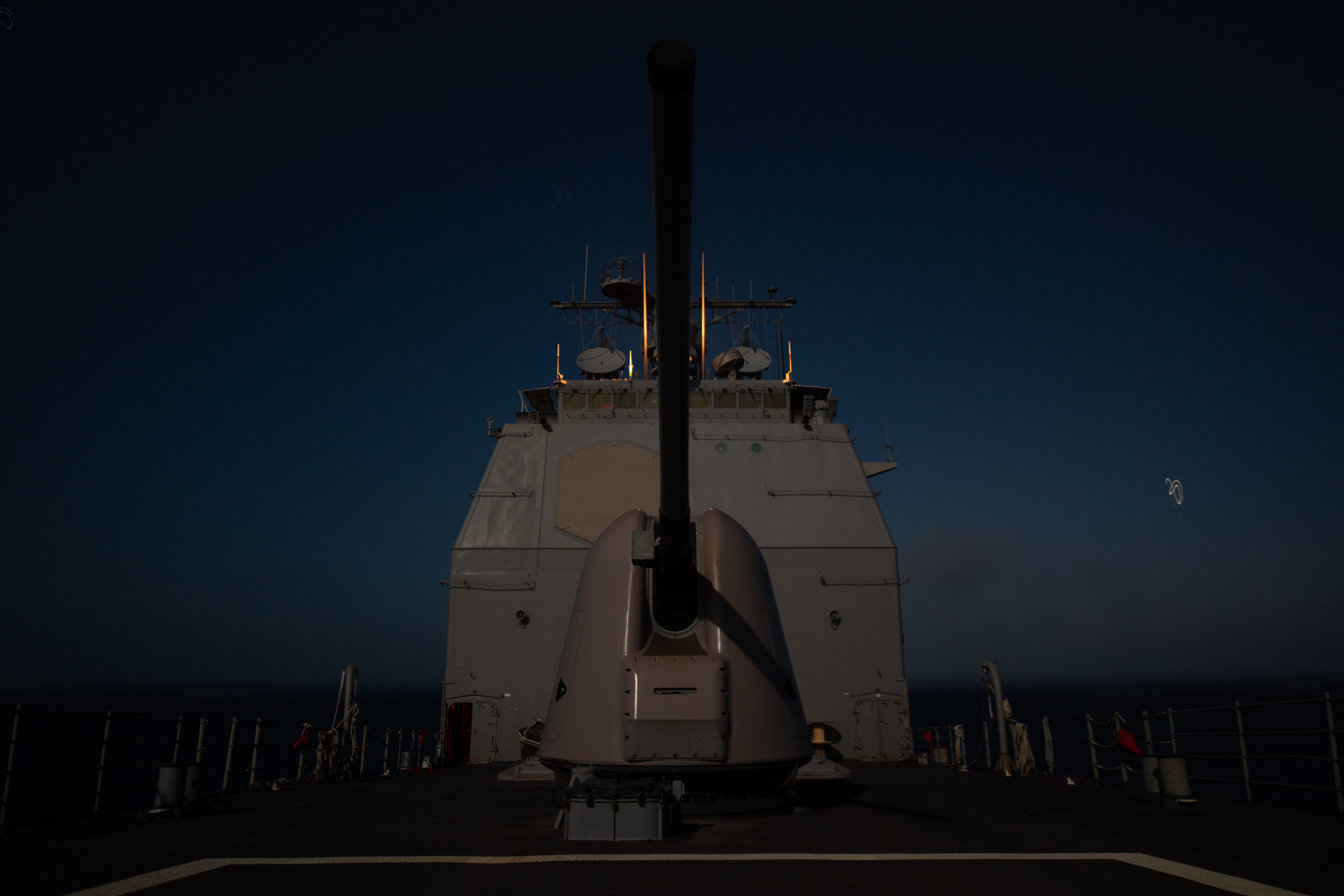
USS Princeton (CG-59) steams through the night on Dec. 28, 2020. US Navy Photo USS Princeton (CG-59), homeported in San Diego, Calif.
Destroyer Squadron 9
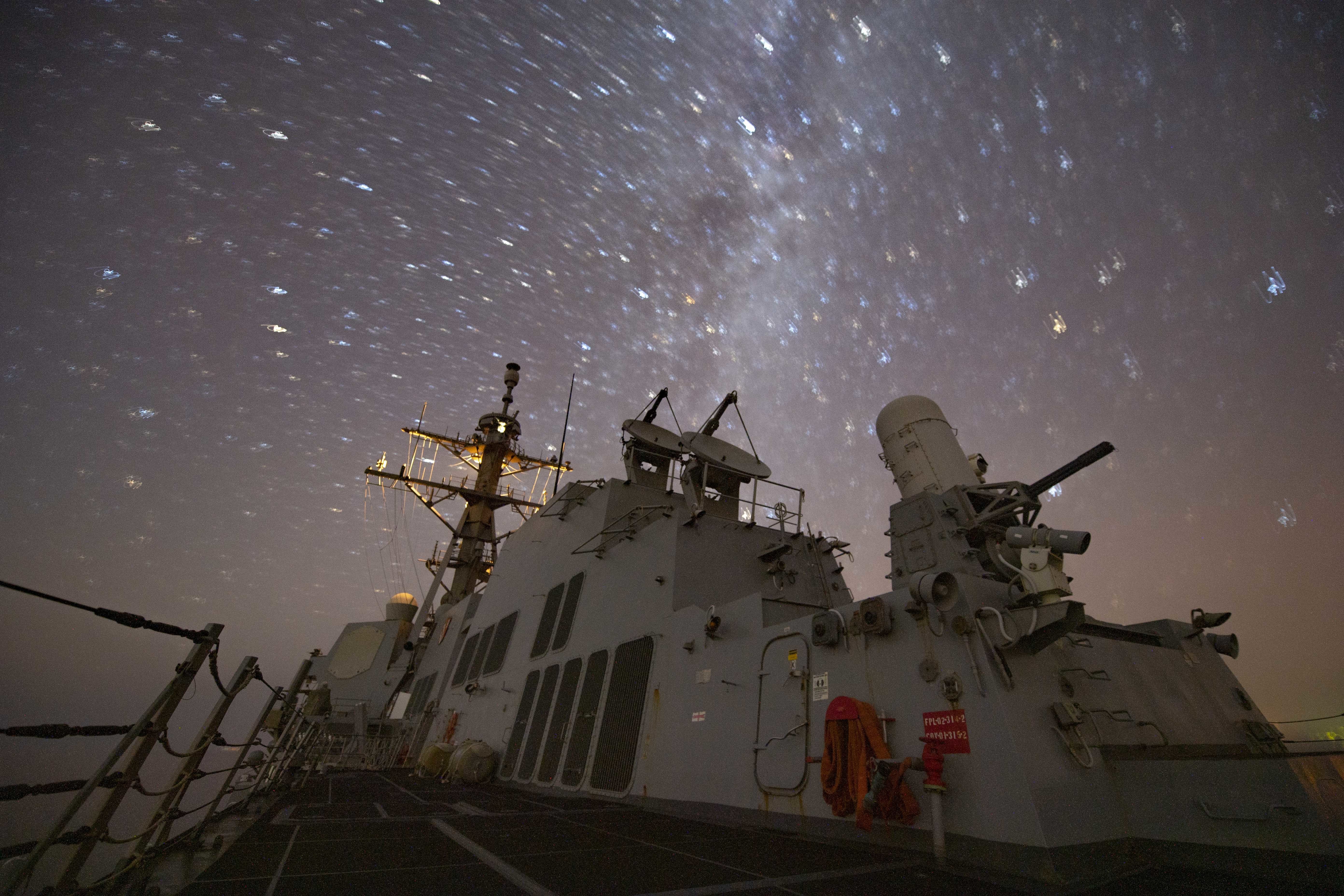
The Arleigh Burke-class guided-missile destroyer USS Sterett (DDG 104) steams in the Gulf of Oman at night on Sept. 8, 2020. Sterett is part of the Nimitz Carrier Strike Group and is deployed to the U.S. 5th Fleet area of operations. US Navy photo. Destroyer Squadron 9 is based at Naval Station Everett, Wash. The DESRON commodore and staff are embarked on Nimitz.
- USS John Paul Jones (DDG-53), homeported in Pearl Harbor, Hawaii
- USS Sterett (DDG-104), homeported in San Diego, Calif.</li
- USS Ralph Johnson (DDG-114), homeported in Everett, Wash.
Ronald Reagan Carrier Strike Group
June 8 to Nov. 16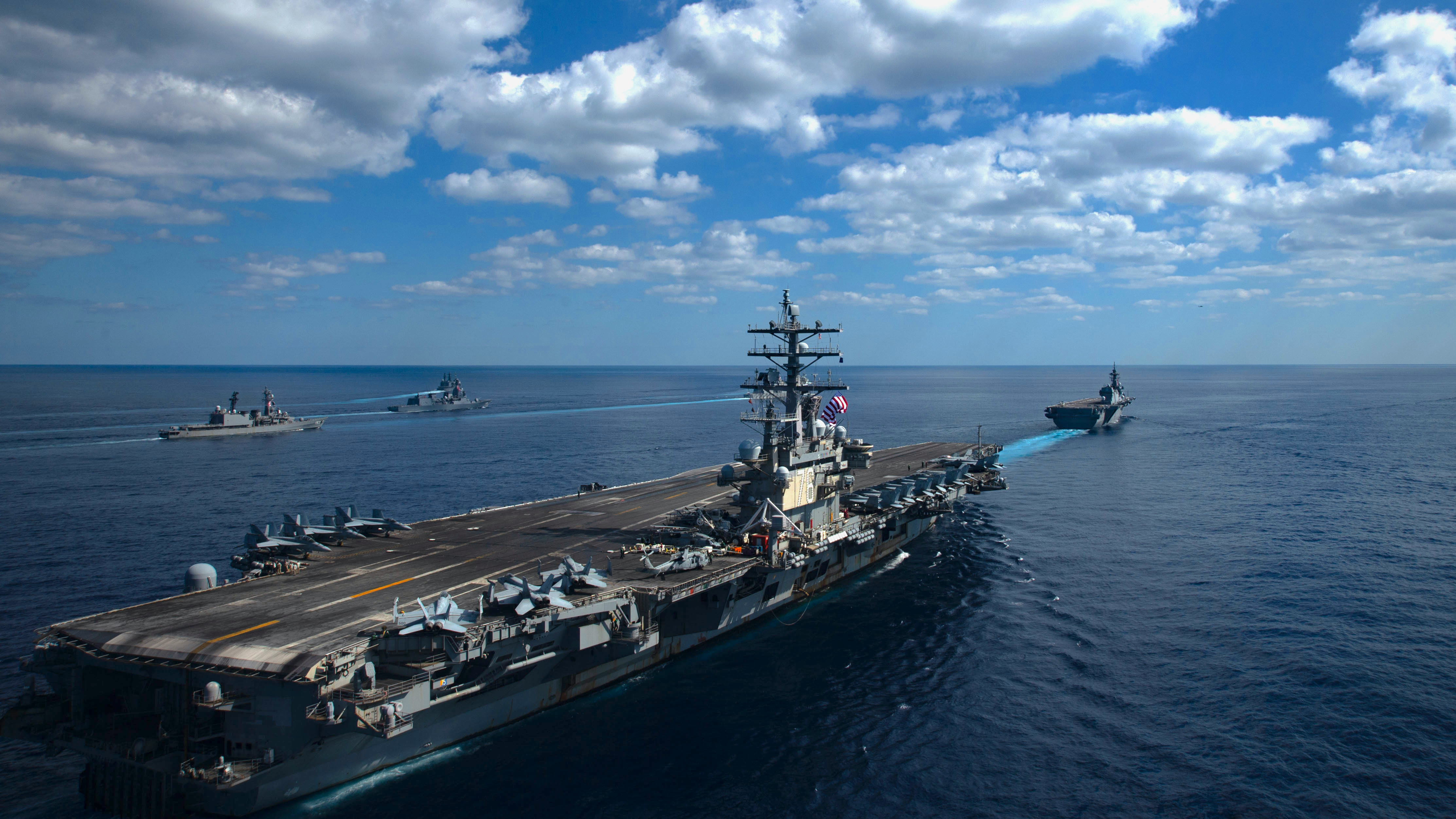
U.S. Navy ships assigned to Ronald Reagan Carrier Strike Group joined ships of Japan Maritime Self-Defense Force (JMSDF) Escort Flotilla 1, Escort Flotilla 4, and the Royal Canadian Navy, in formation during Keen Sword 21 on Oct. 26, 2020. US Navy Photo The forward-deployed Ronald Reagan Carrier Strike Group typically conducts two patrols a year. In 2020, the two patrols extended into one almost six-month-long float in the Western Pacific, from June to November. Following sea-trials after its maintenance period, USS Ronald Reagan (CVN-76) left for its patrol in June.
“Reagan had been on patrol for 159 days, the longest patrol for a Japan-based carrier since 1999. In 1999, then Forward Deployed Naval Force-based USS Kitty Hawk (CV-63) was on patrol for 176 days in the Middle East and the Western Pacific, according to USNI News carrier deployment data,” reported USNI News in November.
In July, Reagan partnered with Nimitz for dual-carrier operations in the South China Sea. In addition to the South China Sea, Reagan also operated off the Western Coast of Australia and extensively in the Philippine Sea.
In September, both Reagan and USS America (LHA-6) participated in the biannual Valiant Shield 2020 exercise off of Guam.
Carrier Strike Group 5
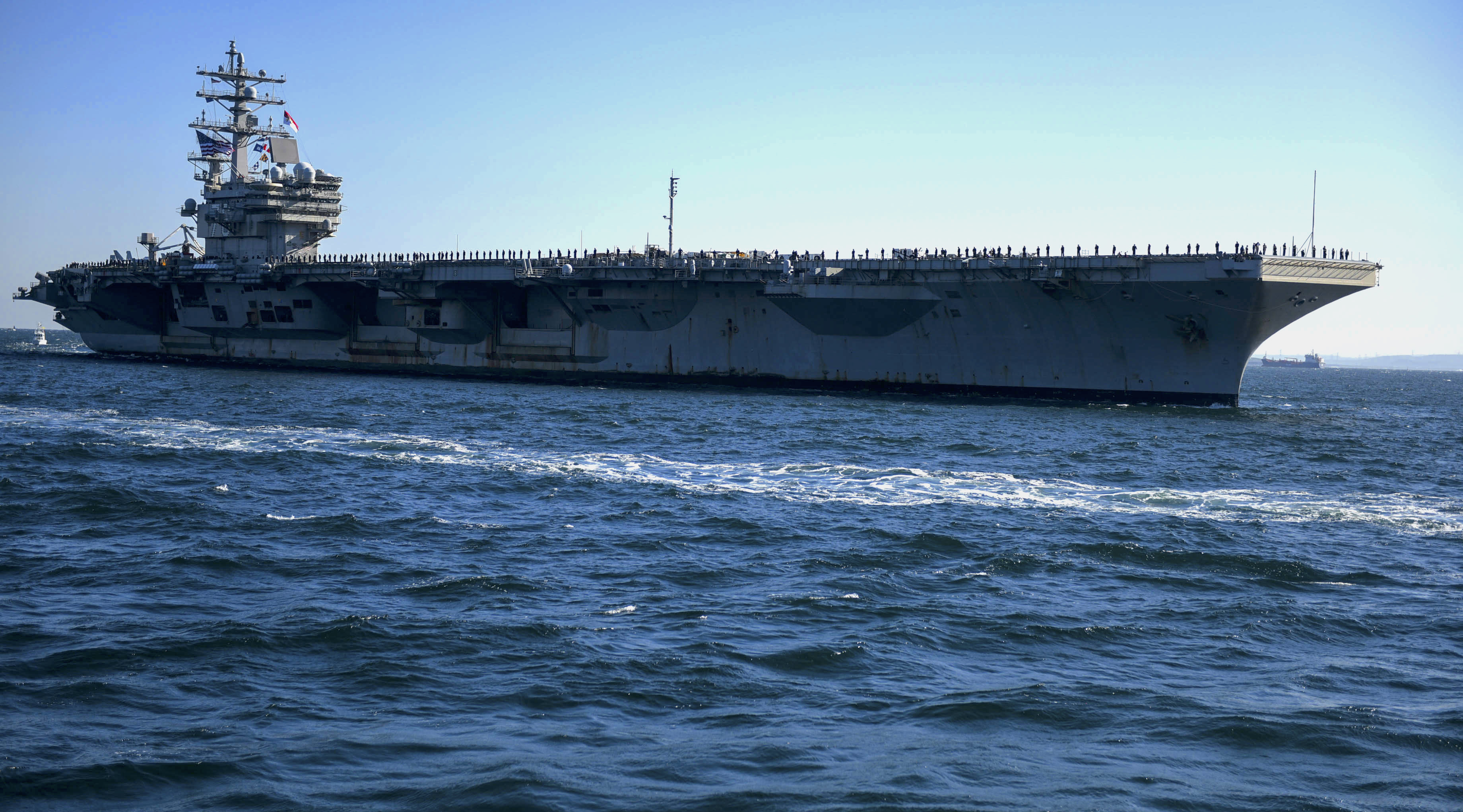
USS Ronald Reagan (CVN-76) returns to its homeport of Commander, Fleet Activities Yokosuka (CFAY) on Nov. 14, 2020. US Navy Photo Yokosuka-based CSG 5 commands the Reagan Carrier Strike Group and is embarked on the carrier.
Aircraft carrier
USS Ronald Reagan (CVN-76), homeported in Yokosuka, Japan.Carrier Air Wing 5
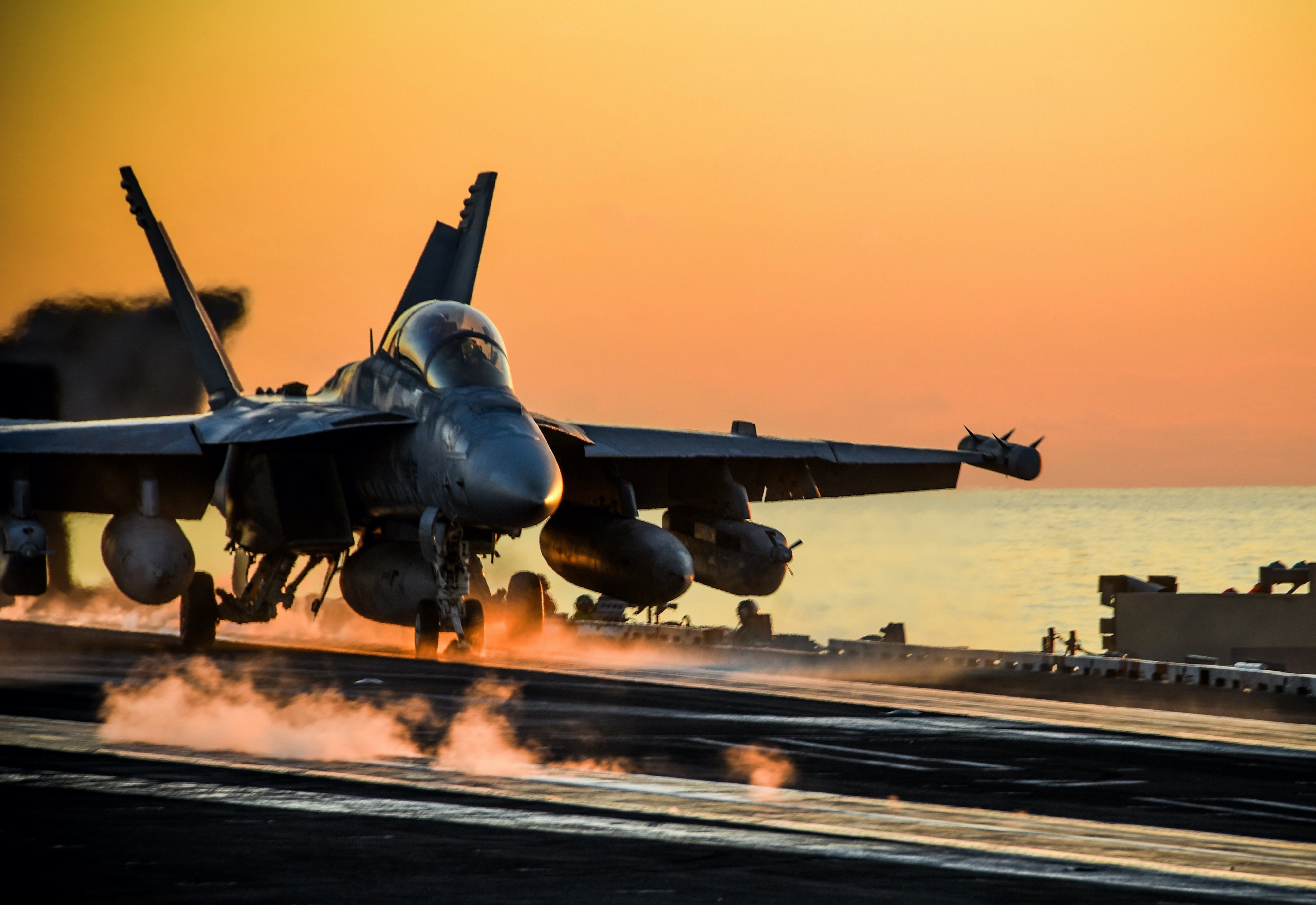
An EA-18G Growler, attached to the ‘Shadowhawks’ of Electronic Attack Squadron (VAQ) 141, takes off from the flight deck of the Navy’s only forward-deployed aircraft carrier USS Ronald Reagan (CVN-76) during Keen Sword 21 on Oct. 28, 2020. US Navy Photo Carrier Air Wing 5, based at Marine Corps Air Station Iwakuni, Japan, is embarked aboard Ronald Reagan and includes a total of nine squadrons and detachments:
- The “Royal Maces” of Strike Fighter Squadron (VFA) 27 from Marine Corps Air Station Iwakuni
- The “Diamondbacks” of VFA-102 from Marine Corps Air Station Iwakuni
- The “Eagles” of VFA-115 from Marine Corps Air Station Iwakuni
- The “Dambusters” of VFA-195 from Marine Corps Air Station Iwakuni
- The “Shadowhawks” of Electronic Attack Squadron (VAQ) 141 Marine Corps Air Station Iwakuni
- The “Tigertails” of Carrier Airborne Early Warning Squadron (VAW) 125 from Marine Corps Air Station Iwakuni
- The “Providers” of Fleet Logistics Support Squadron (VRC) 30 Det 5 from Marine Corps Air Station Iwakuni
- The “Golden Falcons” of Helicopter Sea Combat Squadron (HSC) 5 from Naval Station Atsugi, Japan
- The “Saberhawks” of Helicopter Maritime Strike Squadron (HSM) 77 from Naval Air Station Atsugi
Cruiser
USS Antietam (CG-54), homeported in YokosukaDestroyer Squadron 15
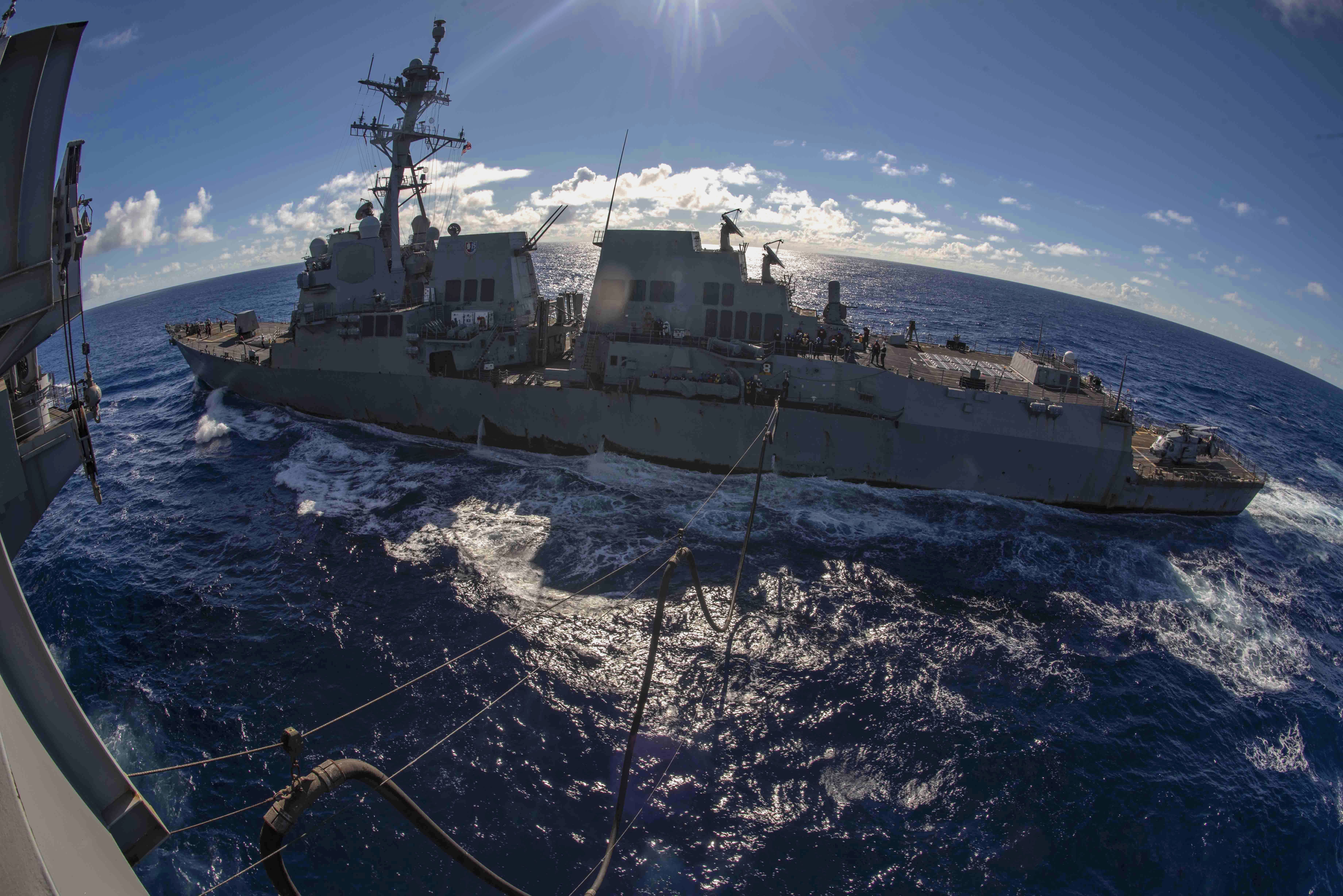
Guided-missile destroyer USS Mustin (DDG-89) conducts a replenishment-at-sea with the Navy’s only forward-deployed aircraft carrier USS Ronald Reagan (CVN-76) on Sept. 7, 2020. US Navy Photo Destroyer Squadron 15 is based in Yokosuka, Japan, and was embarked on the carrier. 7th Fleet did not specify the escorts accompanying Reagan on its patrol, but the CSG includes:
- USS Mustin (DDG-89), homeported in Yokosuka
Makin Island ARG & 15th MEU
Nov. 23 to Present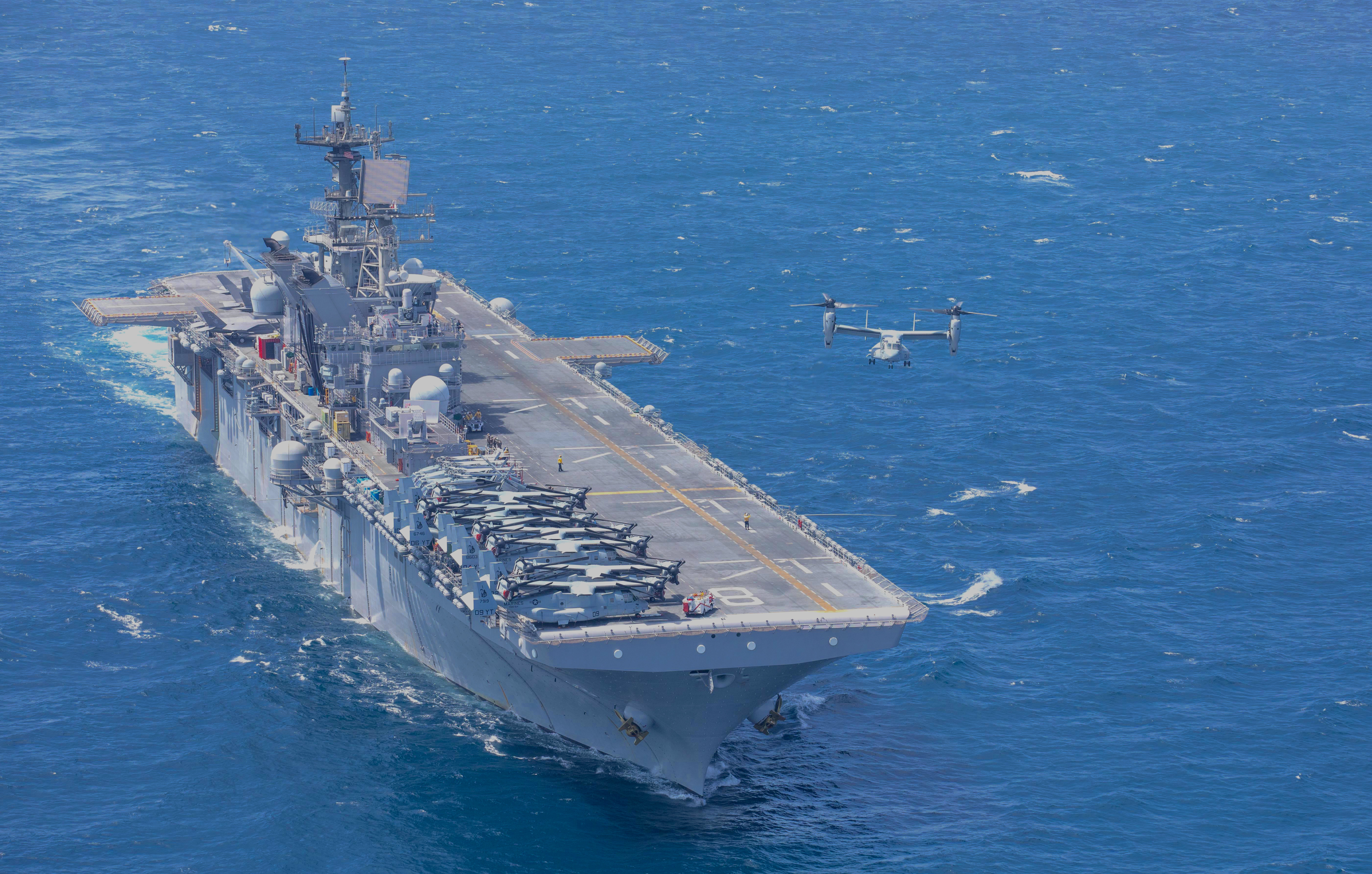
Makin Island Amphibious Ready Group, consisting of USS Makin Island (LHD-8), USS Somerset (LPD-25), USS San Diego (LPD-22), and embarked 15th Marine Expeditionary Unit; and USS Hershel ‘Woody’ Williams (ESB-4) conduct maritime operations off the coast of Somalia under Joint Task Force – Quartz in support of Operation Octave Quartz (OOQ) Dec. 22, 2020. US Navy Photo After months of work-ups off the coast of California, the Makin Island Amphibious Ready Group and the 15th Marine Expeditionary Unit departed in October for the final series of exercises ahead of deployment.
Operating near Hawaii in late November, USS Makin Island (LHD-8), USS San Diego (LPD-22) and USS Somerset (LPD-25) and the MEU began the deployment.
In early December, the ARG was operating in the South China Sea, drawing condemnation from Chinese officials, before drilling with the Republic of Singapore Navy. Mid-month, the ARG transited the Indian Ocean and entered the Middle East to support Operation Octave Quartz – relocating U.S. troops from Somalia.
America Expeditionary Strike Group & 31st MEU
Jan. 10 to May 4
Aug. 4 to Oct. 24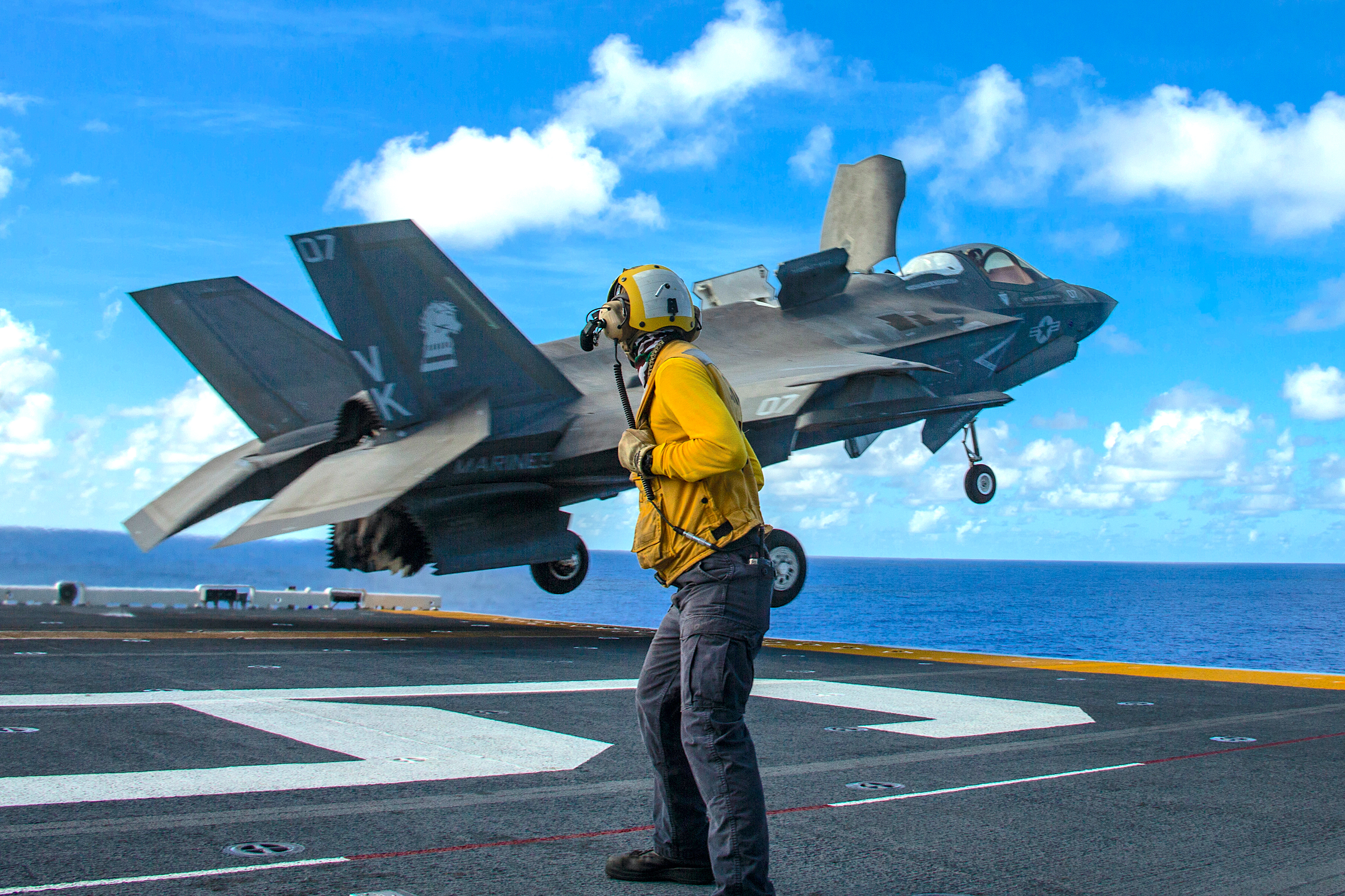
An F-35B Lightning II fighter aircraft with Marine Medium Tiltrotor Squadron (VMM) 265 (Reinforced), 31st Marine Expeditionary Unit (MEU), takes off from the flight deck of amphibious assault ship USS America (LHA-6) during an air defense exercise March 23, 2020. US Marine Corps While Theodore Roosevelt was battling the COVID-19 outbreak in Guam, forward-deployed USS America (LHA-6) steamed extensively in the South China Sea in the early part of the year.
America was a key U.S. asset for presence operations near contested waters in the South China Sea that were part of a natural resources dispute between Malaysia and China.
The ship embarked with the 31st Marine Expeditionary Unit – which included a squadron of F-35B Lightning II Joint Strike Fighters.
Bataan ARG & 26th MEU
Dec. 20, 2019 to July 15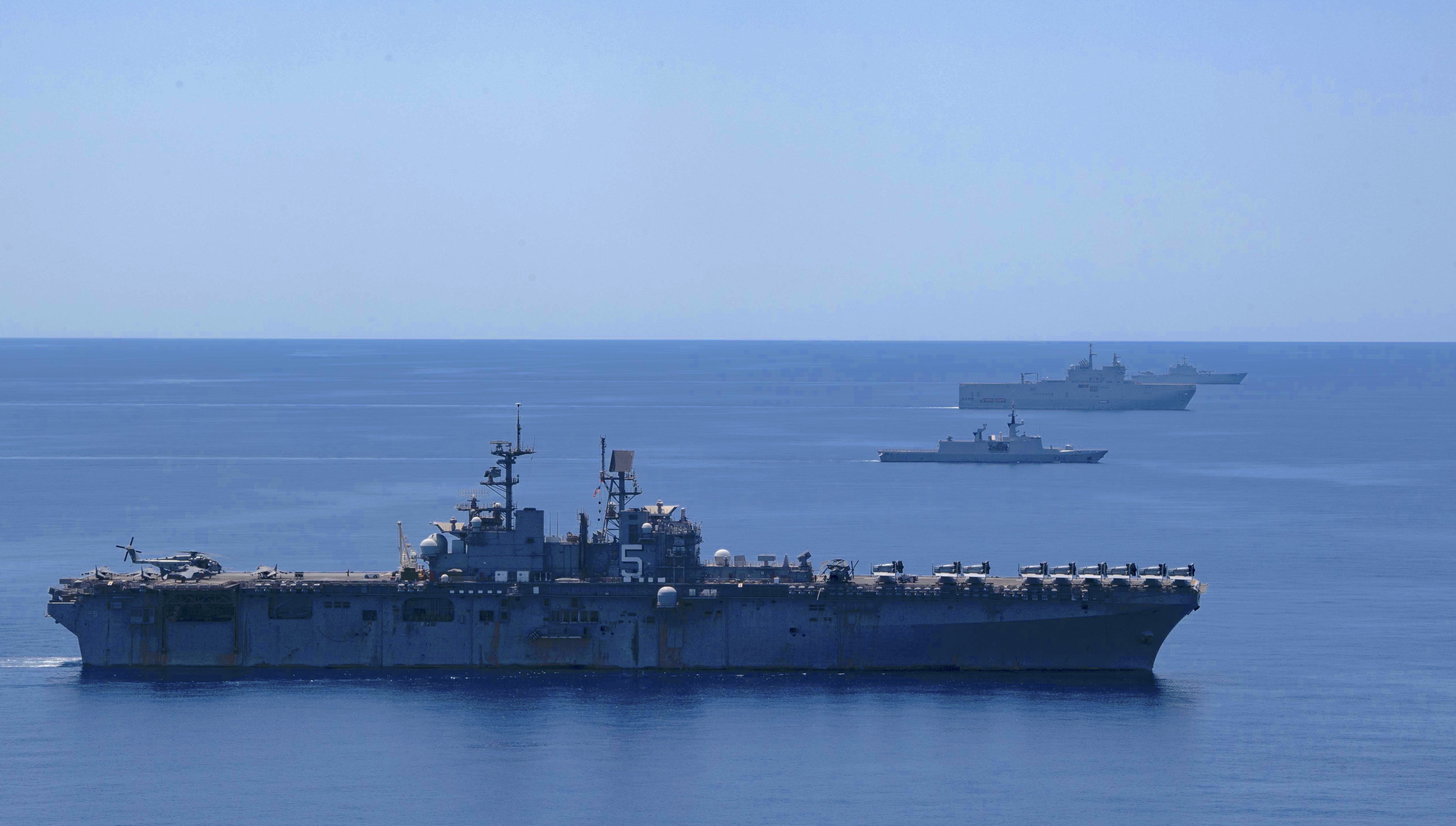
USS Bataan (LHD-5), front, the French frigate navy Guepratte (F-714), the French navy amphibious assault ship FS Mistral (L9013) and the Italian navy amphibious transport dock ship ITS San Giorgio (L9894) are underway in formation as part of a maritime training exercise on June 24, 2020. US Navy Photo Shortly after deploying from the East Coast, the Bataan ARG and the 26th MEU cancelled planned training with the Moroccan armed forces and were dispatched to the Middle East following the Jan. 2 killing of Quds Force commander Qasem Soleimani in Iraq.
USS Bataan (LHD-5), USS New York (LPD-21) and USS Oak Hill (LSD-51) embarked with the 26th MEU, for a total of 4,500 sailors and Marines. In June, Oak Hill operated in the Black Sea.
The MEU spent the bulk of its deployment in 5th Fleet and U.S. 6th Fleet.
“[The ARG/MEU] team worked with partners from the Kingdom of Saudi Arabia to coordinate multiple complex training evolutions on the uninhabited Karan and Kurayn islands in the Arabian Gulf, as well as with partners from the United Arab Emirates to hold training in an isolated location within that country,” reads a statement from U.S. 2nd Fleet.
The ARG/MEU returned to the East Coast on July 15.





